COMPOUND BAR-LIMB MICROSCOPE WITH A 'CAPTAIN PERRY' ARM MODIFICATION
MAKER:SWIFT
MODEL: 'PRESENTATION MICROSCOPE'
c.1877
SIGNED: 'JAMES SWIFT, 43 UNIVERSITY ST, LONDON W.C. PATENT'
Please Click On Any Picture for a Larger Version, and More details, where available
Please Click On Any Picture for a Larger Version, Where Available
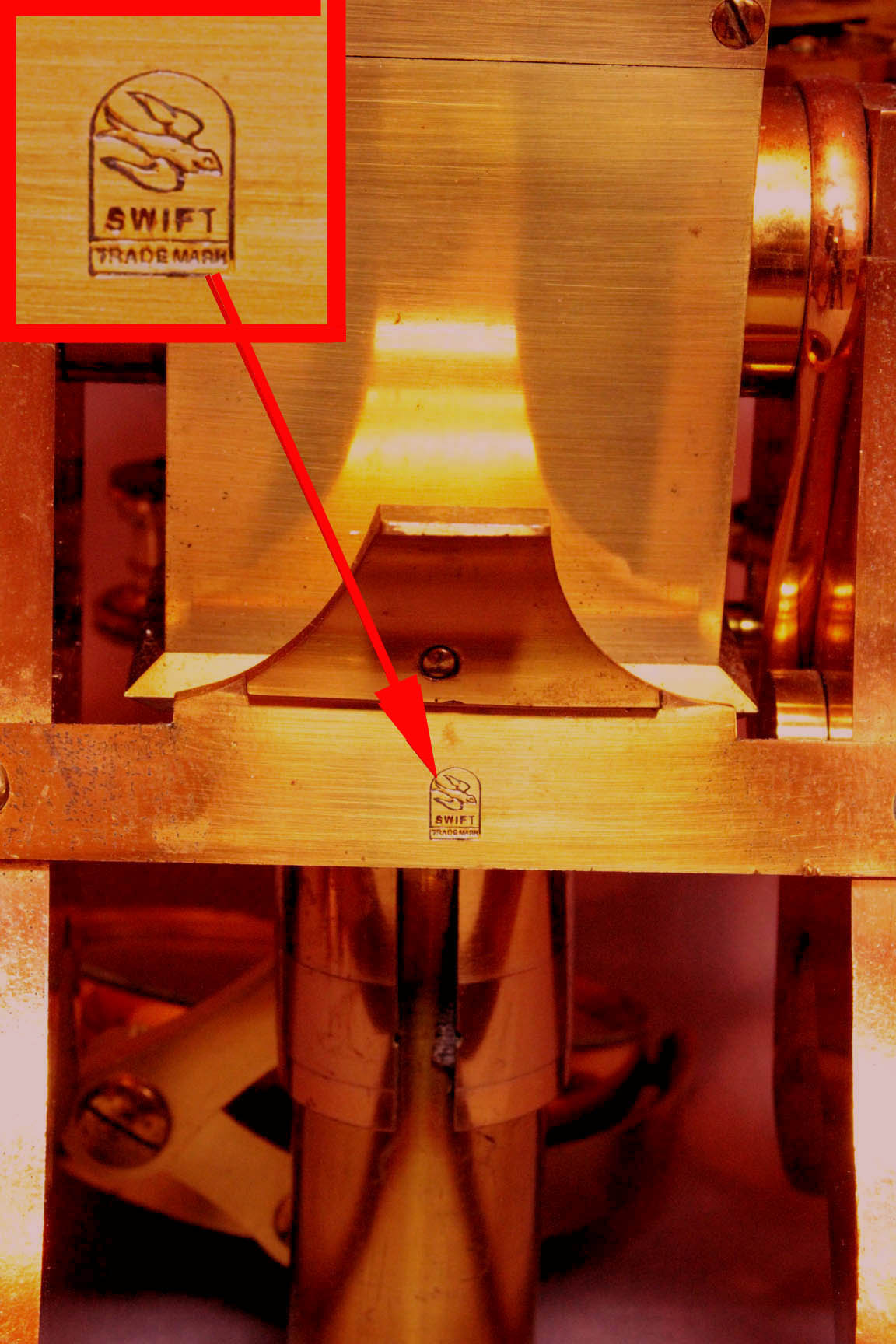
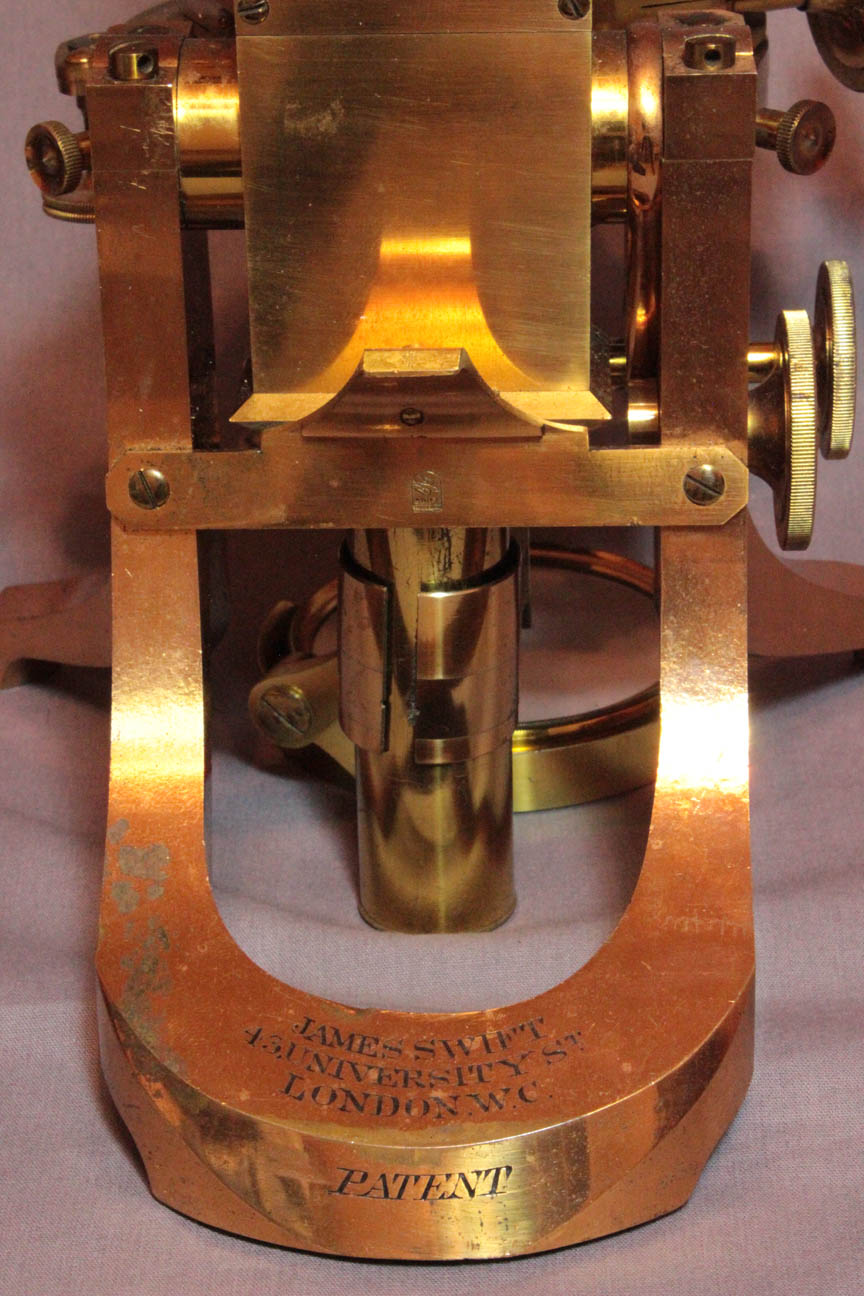 DESCRIPTION: This is an all lacquered-brass compound binocular bar-limb microscope with a 'Captain Perry' arm modification. It is signed on the rear bottom portion of the foot: 'James Swift, 43 University St, London W.C., PATENT'. The bird trademark of the Swift is engraved on the rear crossbar. The microscope limb is mounted on the trunnions of a Swift-type English tripod foot. There is a knurled knob on the right side of the microscope attached to a cam which moves a bar which acts as a clutch to adjust the tension of the inclination joint. The arm has the Captain Perry modification which forms part of the casting of the arm; i.e. the arm with the Perry Modification is a single piece of brass. The arm is fastened to the top of the bar and held in place with a set screw. The top of the Perry modification is fastened by two screws to the right binocular tube.
DESCRIPTION: This is an all lacquered-brass compound binocular bar-limb microscope with a 'Captain Perry' arm modification. It is signed on the rear bottom portion of the foot: 'James Swift, 43 University St, London W.C., PATENT'. The bird trademark of the Swift is engraved on the rear crossbar. The microscope limb is mounted on the trunnions of a Swift-type English tripod foot. There is a knurled knob on the right side of the microscope attached to a cam which moves a bar which acts as a clutch to adjust the tension of the inclination joint. The arm has the Captain Perry modification which forms part of the casting of the arm; i.e. the arm with the Perry Modification is a single piece of brass. The arm is fastened to the top of the bar and held in place with a set screw. The top of the Perry modification is fastened by two screws to the right binocular tube.
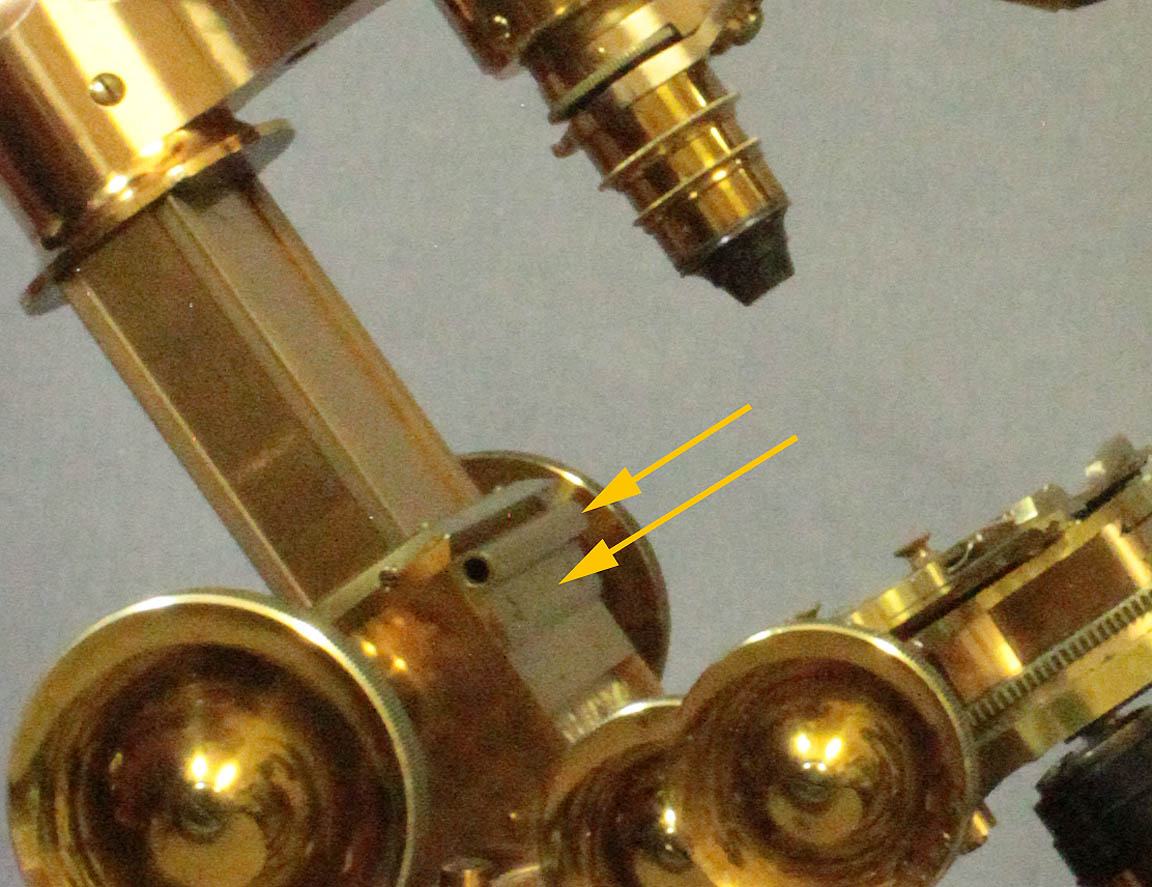 The limb has a small brass plate(yellow arrows, left), screwed to the front, providing a hole on each side of the limb for attachment of accessories; this is identical to the plate used on earlier Ross bar limbs. The lever fine focus is controlled by a micrometer screw in the middle of the arm. The binocular tube incorporates a Wenham prism in a small drawer which can be pulled out the optical axis to allow the microscope to be used as a monocular. Above the Wenham prism drawer is another small drawer containing an analyzer; this is a Swift innovation allowing the use of the analyzer and polarizer with the binocular configuration with less distortion than a nosepiece analyzer inserted below the Wenham prism, and with less vignetting(reducing the effective field of view) than with an eyepiece analyzer. Interocular distance of the binocular tubes is adjusted by rack and pinion, the left side spiral or diagonal, the right side straight. Coarse focus is by diagonal rack and pinion to the wide bar. All scales on this instrument are silvered including the rotation for the substage and the fine focus knob.
The limb has a small brass plate(yellow arrows, left), screwed to the front, providing a hole on each side of the limb for attachment of accessories; this is identical to the plate used on earlier Ross bar limbs. The lever fine focus is controlled by a micrometer screw in the middle of the arm. The binocular tube incorporates a Wenham prism in a small drawer which can be pulled out the optical axis to allow the microscope to be used as a monocular. Above the Wenham prism drawer is another small drawer containing an analyzer; this is a Swift innovation allowing the use of the analyzer and polarizer with the binocular configuration with less distortion than a nosepiece analyzer inserted below the Wenham prism, and with less vignetting(reducing the effective field of view) than with an eyepiece analyzer. Interocular distance of the binocular tubes is adjusted by rack and pinion, the left side spiral or diagonal, the right side straight. Coarse focus is by diagonal rack and pinion to the wide bar. All scales on this instrument are silvered including the rotation for the substage and the fine focus knob.
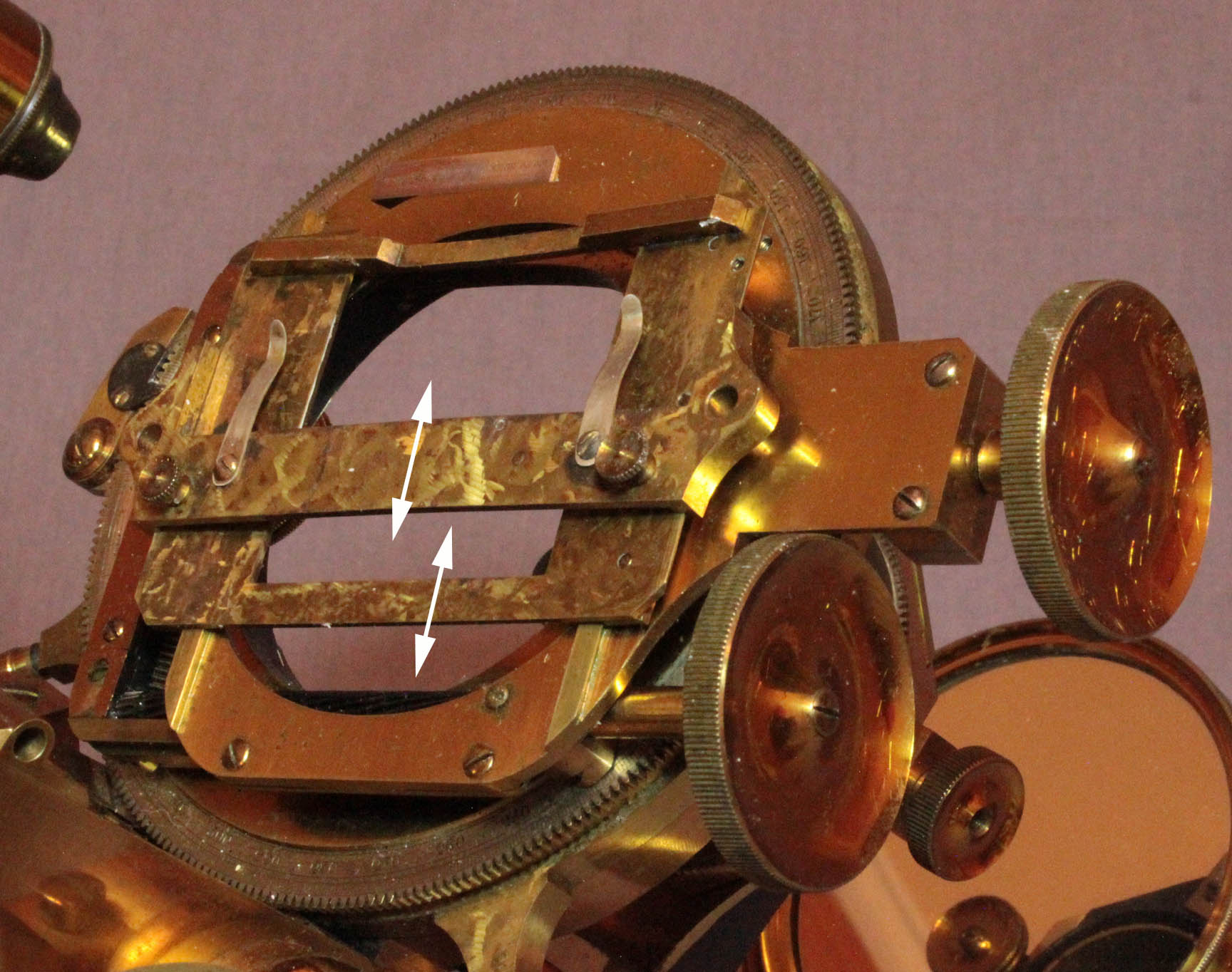 The mechanical stage has separate controls for X and Y motion and rotates via a pinion controlled by a knurled knob below the left side of the stage. This gear can be disengaged for manual rotation by moving the gear housing aside. The stage calibrations include silvered scales for X and Y movements as well as a silvered rotational scale. The rotation scale is calibrated from 0-360 degrees in half degree increments, labeled every ten degrees. The finely divided stage X and Y calibrations are labeled from 0 to 100 in single increments and labeled every ten. In use, the slide sits on a top plate which can be pushed forward or backward on rails on top of the mechanical stage, independently of the mechanical movements; this allows one to quickly move to an area of interest, and then use the controls of the stage for finer movements. One slide rest on this plate is fixed, but the other can be moved forward or backward on the moveable plate on which the slide sits. The moveable slide rest has two stage clips and a hole on each side to accept the stage-mounting accessories such as the stage forceps, as an alternative to the holes on the side of the limb. The entire stage is provided with adjustments for centering via knurled knobs on each side.
The mechanical stage has separate controls for X and Y motion and rotates via a pinion controlled by a knurled knob below the left side of the stage. This gear can be disengaged for manual rotation by moving the gear housing aside. The stage calibrations include silvered scales for X and Y movements as well as a silvered rotational scale. The rotation scale is calibrated from 0-360 degrees in half degree increments, labeled every ten degrees. The finely divided stage X and Y calibrations are labeled from 0 to 100 in single increments and labeled every ten. In use, the slide sits on a top plate which can be pushed forward or backward on rails on top of the mechanical stage, independently of the mechanical movements; this allows one to quickly move to an area of interest, and then use the controls of the stage for finer movements. One slide rest on this plate is fixed, but the other can be moved forward or backward on the moveable plate on which the slide sits. The moveable slide rest has two stage clips and a hole on each side to accept the stage-mounting accessories such as the stage forceps, as an alternative to the holes on the side of the limb. The entire stage is provided with adjustments for centering via knurled knobs on each side.
The substage also has rack and pinion rotation as well as diagonal rack and spiral pinion focusing. Two knurled knobs control centration of the substage fitting.
The gimbaled plane and concave double sided mirror is attached to the round tailpiece via an articulated arm on a ring which can be moved up and down the tailpiece.
It came with its 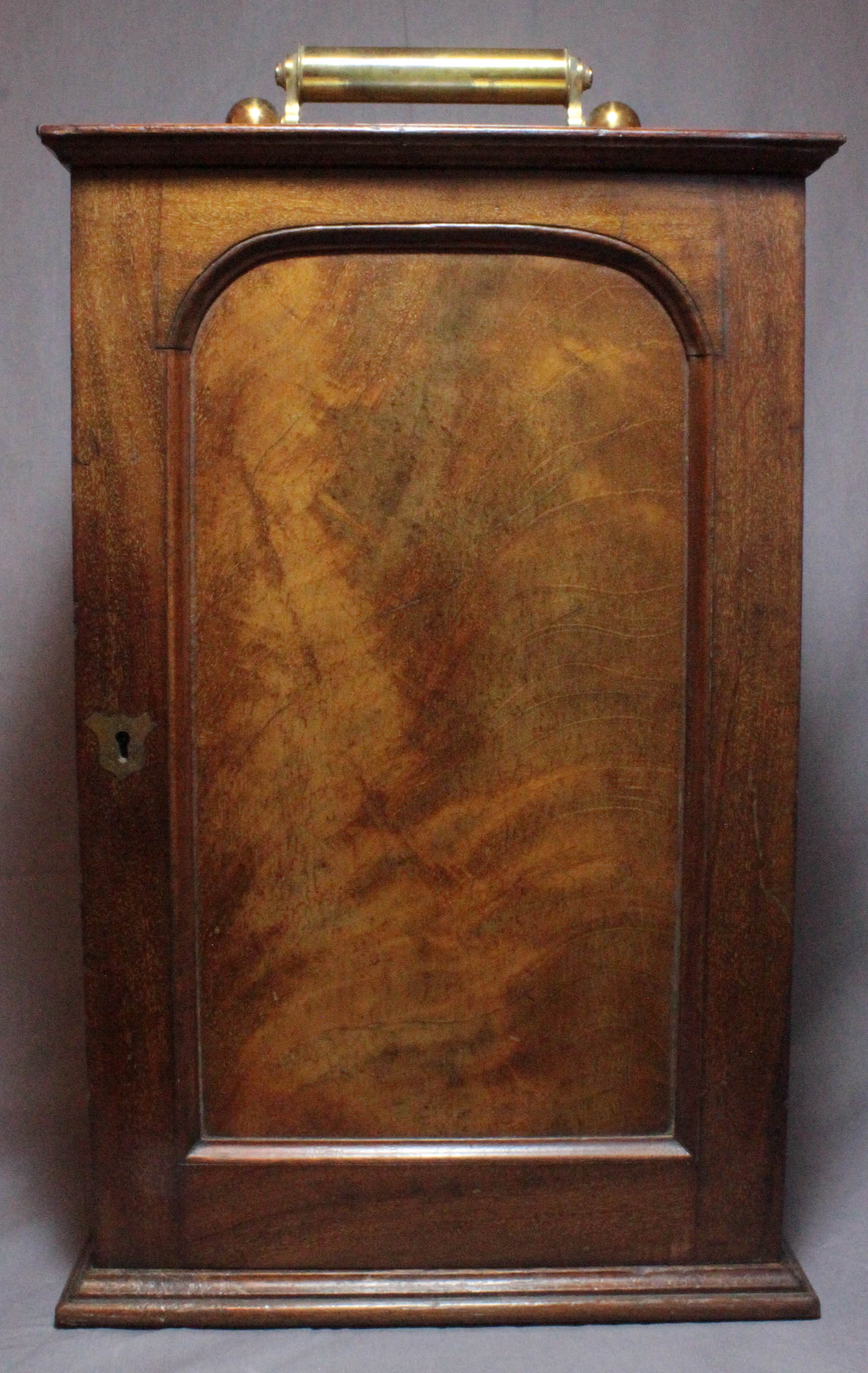 original case, with furniture to store the two accessory boxes, the bullseye stand condenser, and the microspectroscope. It has a working lock and key. There is also a separate key for the larger of the two accessory boxes.
original case, with furniture to store the two accessory boxes, the bullseye stand condenser, and the microspectroscope. It has a working lock and key. There is also a separate key for the larger of the two accessory boxes.
The microscope stand itself is equipped with all the options offered in the c. 1874 catalog, which would have made it the most expensive stand Swift sold at that time.
ACCESSORIES:
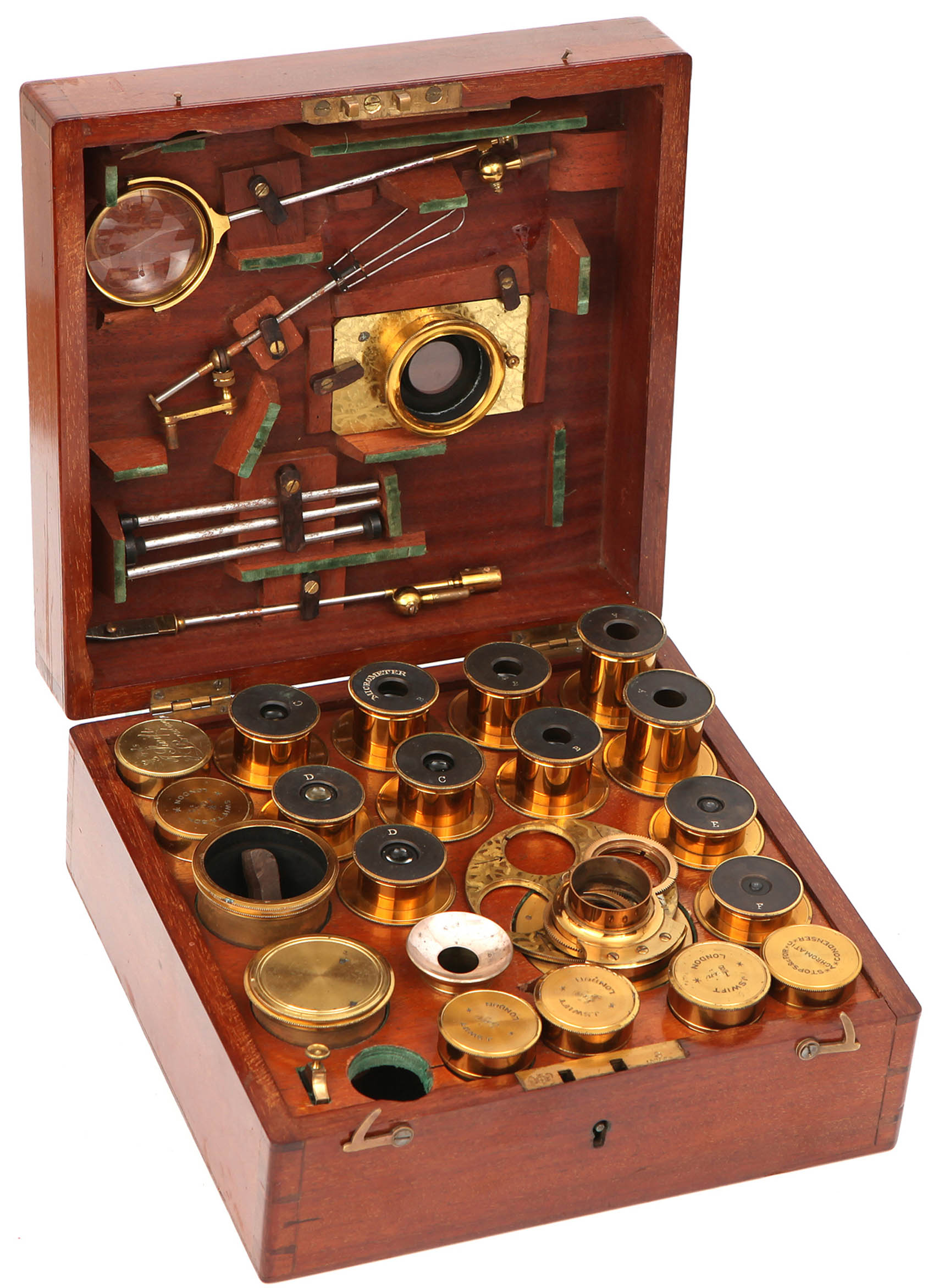
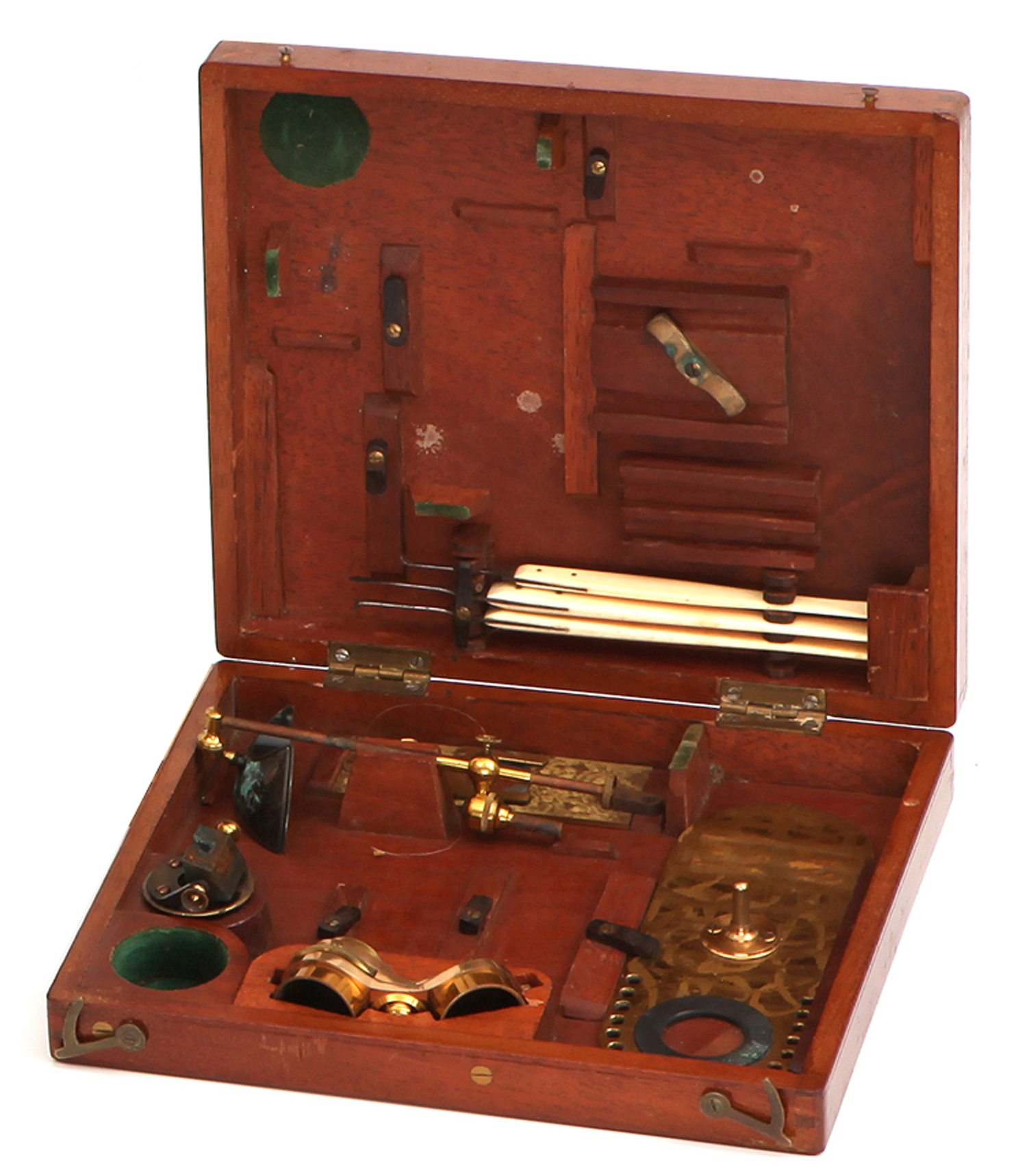 There is a nice complement of accessories. Most are housed in two boxes fitting into the main case. They include a good selection of eyepieces, objectives, above stage fittings, and condenser fittings. There is also a microspectroscope and Swift's largest telescoping stand-alone Bullseye Condenser. The microspectroscope and bench condenser store separately in the main case. Among the substage accessories is a Hall type Universal condenser as modified and improved by Swift.
There is a nice complement of accessories. Most are housed in two boxes fitting into the main case. They include a good selection of eyepieces, objectives, above stage fittings, and condenser fittings. There is also a microspectroscope and Swift's largest telescoping stand-alone Bullseye Condenser. The microspectroscope and bench condenser store separately in the main case. Among the substage accessories is a Hall type Universal condenser as modified and improved by Swift.
SUBSTAGE:
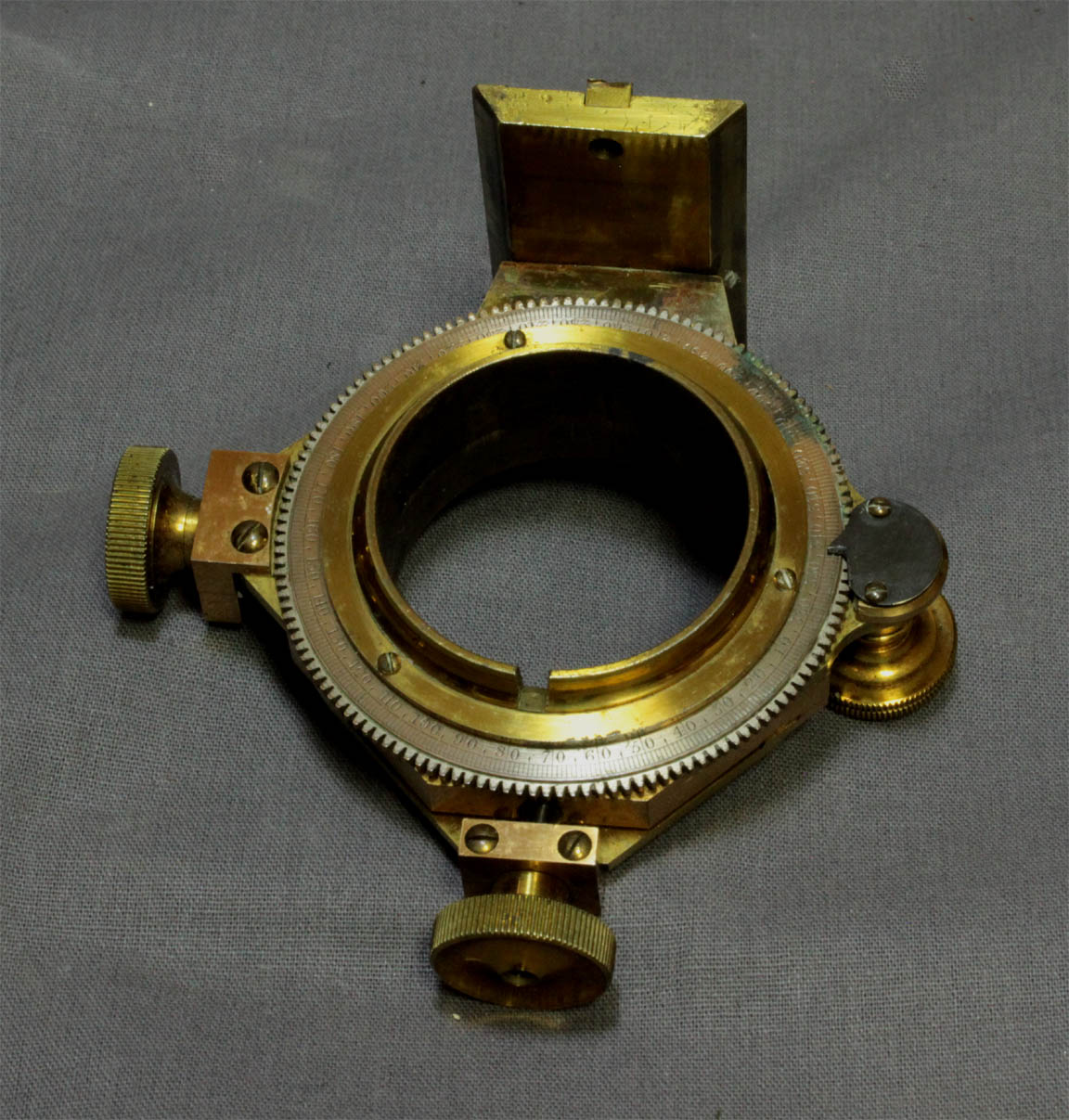
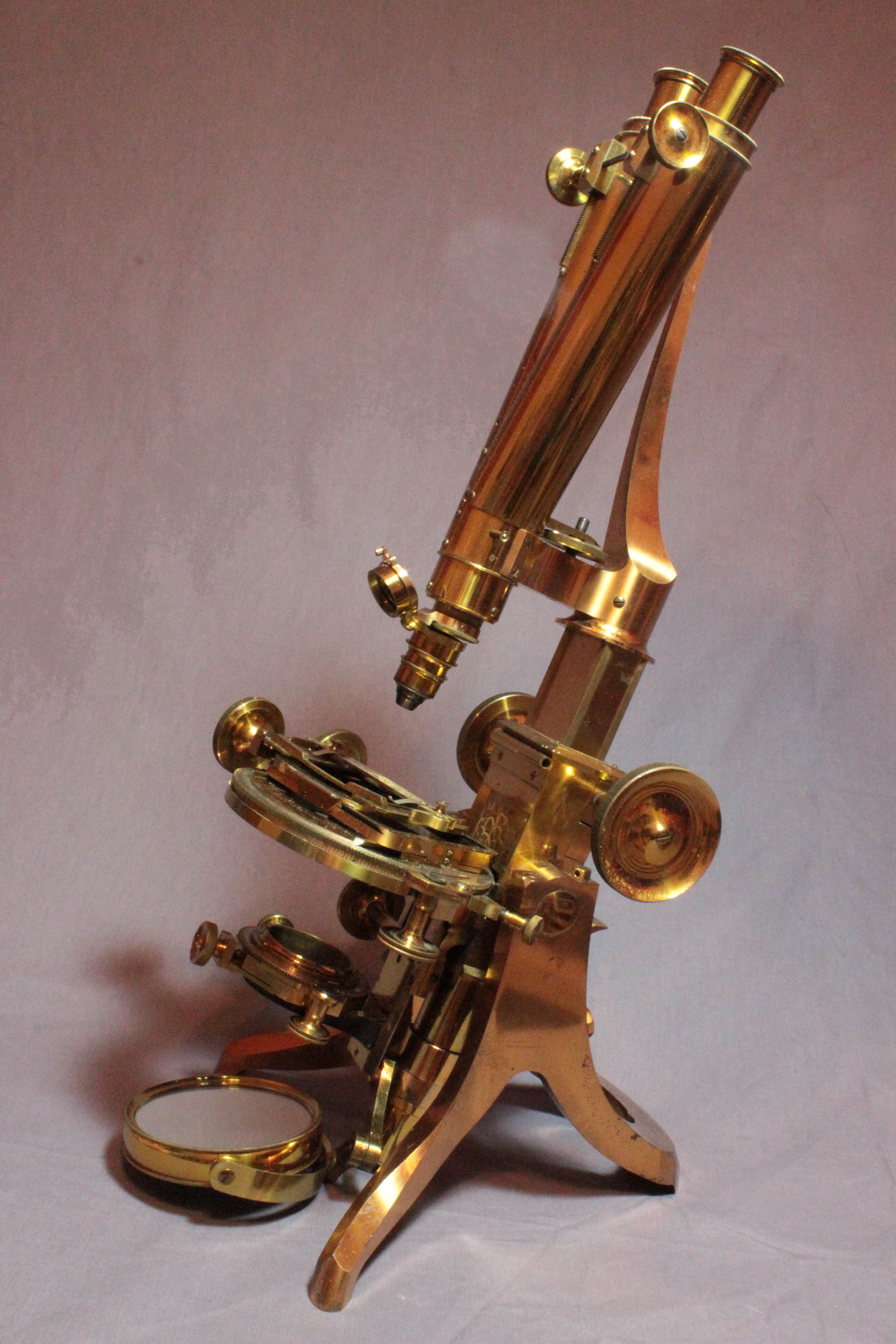 The substage accepts the Universal condenser, the paraboloid spot condenser, or the darkwell holder. The substage fitting provides geared rotation with a finely silvered scale indicating the rotation, calibrated in degrees, labeled every ten degrees. It also has controls for centration. Like the optical tube focusing, focusing of the substage is by diagonal rack and spiral pinion-a Swift innovation. Note the slot in the front of the substage to register the Universal condenser.
The substage accepts the Universal condenser, the paraboloid spot condenser, or the darkwell holder. The substage fitting provides geared rotation with a finely silvered scale indicating the rotation, calibrated in degrees, labeled every ten degrees. It also has controls for centration. Like the optical tube focusing, focusing of the substage is by diagonal rack and spiral pinion-a Swift innovation. Note the slot in the front of the substage to register the Universal condenser.
SWIFT UNIVERSAL CONDENSER:
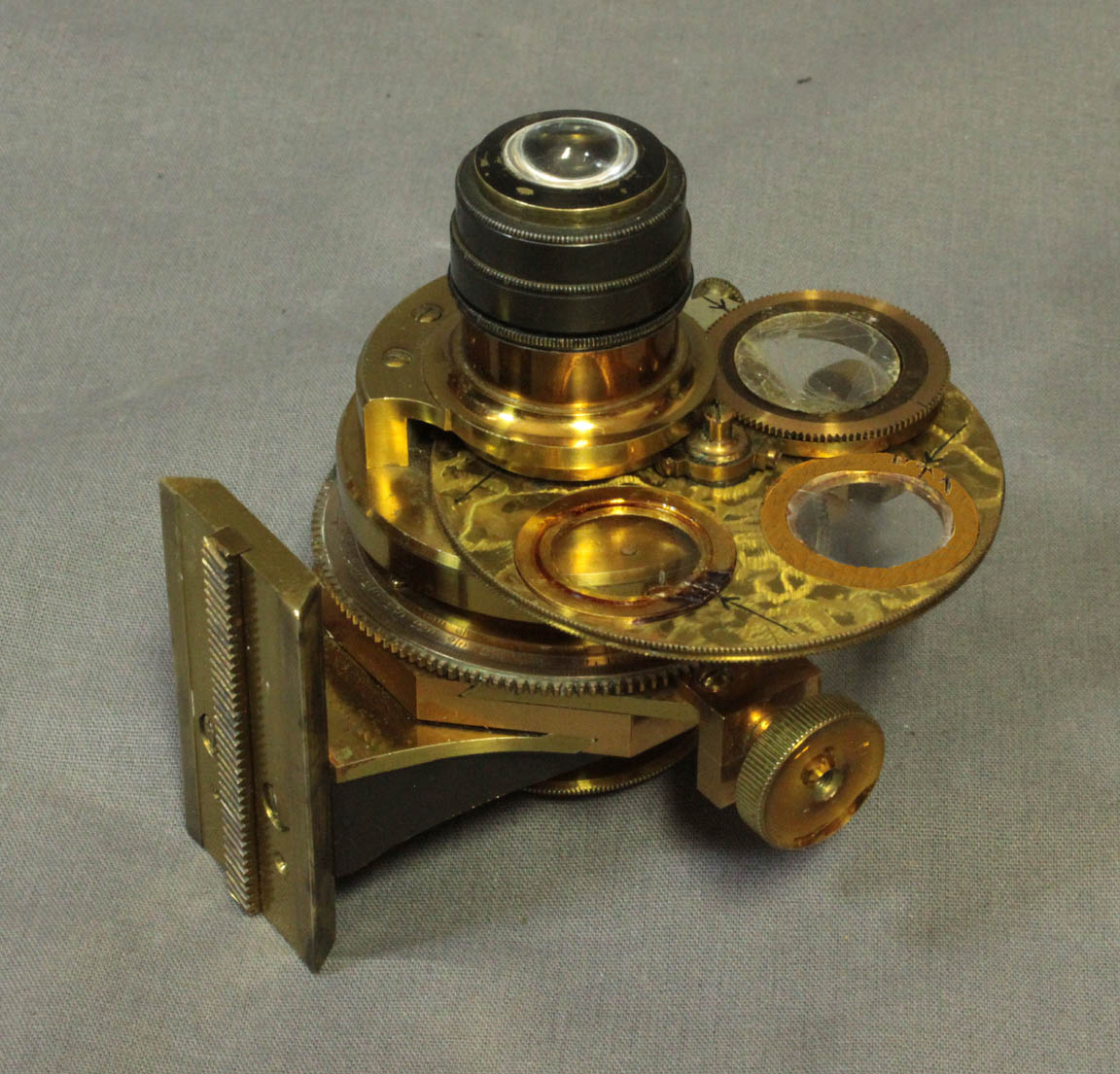
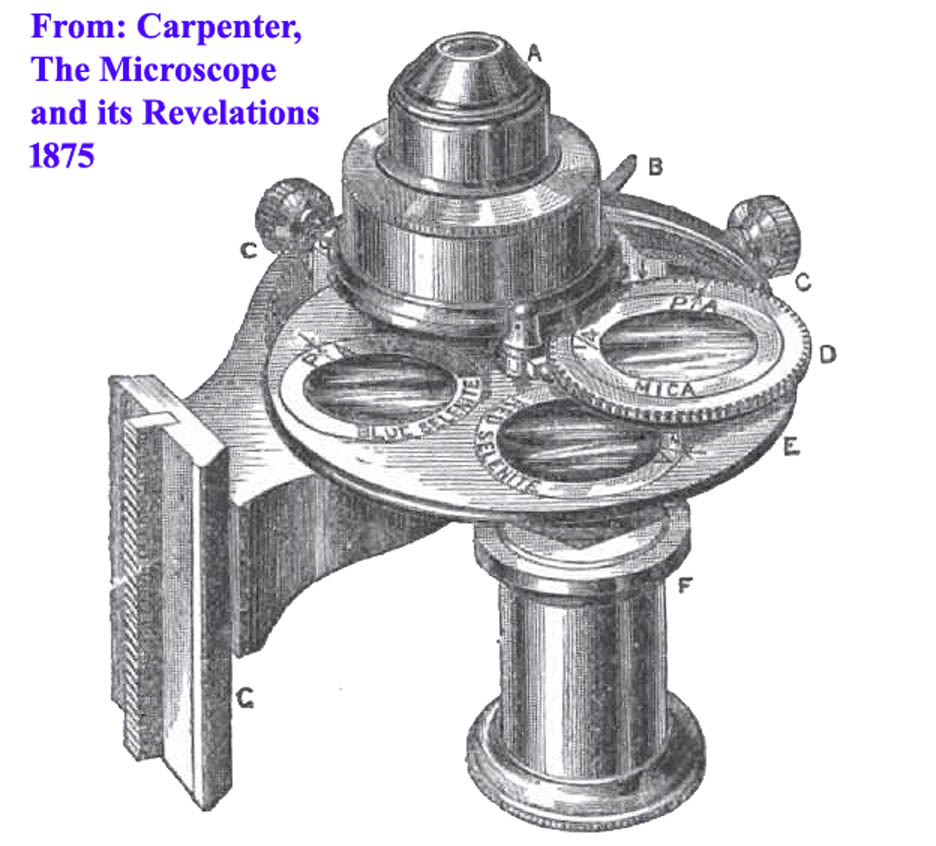 The universal condenser provided with this microscope(shown to the left mounted in the substage fitting), is the achromatic 'Universal' type that Swift improved from the Hall condenser. It is a slightly earlier version than the final version which is shown in the engraving to the right. For more images and details of this interesting accessory, please see the Swift Universal Condenser Page. For Carpenters description of the final form of Swift Universal Condenser, see the excerpt from the 1875 edition of Carpenter, which also describes separate selenite stages.
The universal condenser provided with this microscope(shown to the left mounted in the substage fitting), is the achromatic 'Universal' type that Swift improved from the Hall condenser. It is a slightly earlier version than the final version which is shown in the engraving to the right. For more images and details of this interesting accessory, please see the Swift Universal Condenser Page. For Carpenters description of the final form of Swift Universal Condenser, see the excerpt from the 1875 edition of Carpenter, which also describes separate selenite stages.
SWIFT SPOT PARABOLOID FOR LOW POWERS:
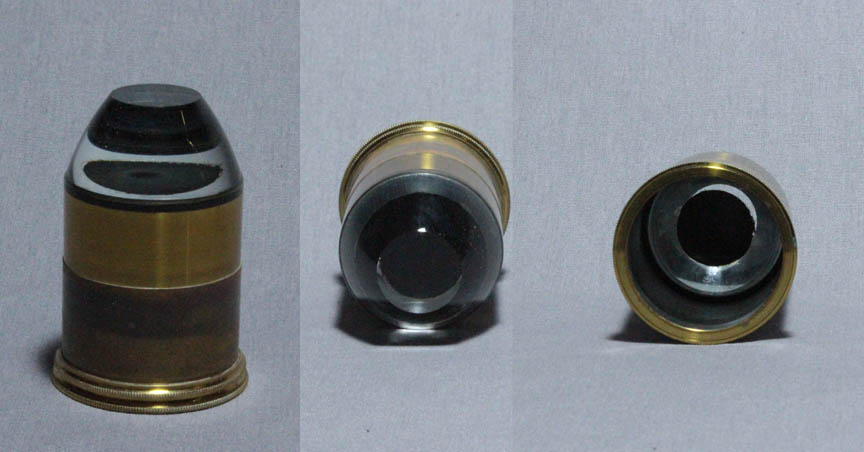
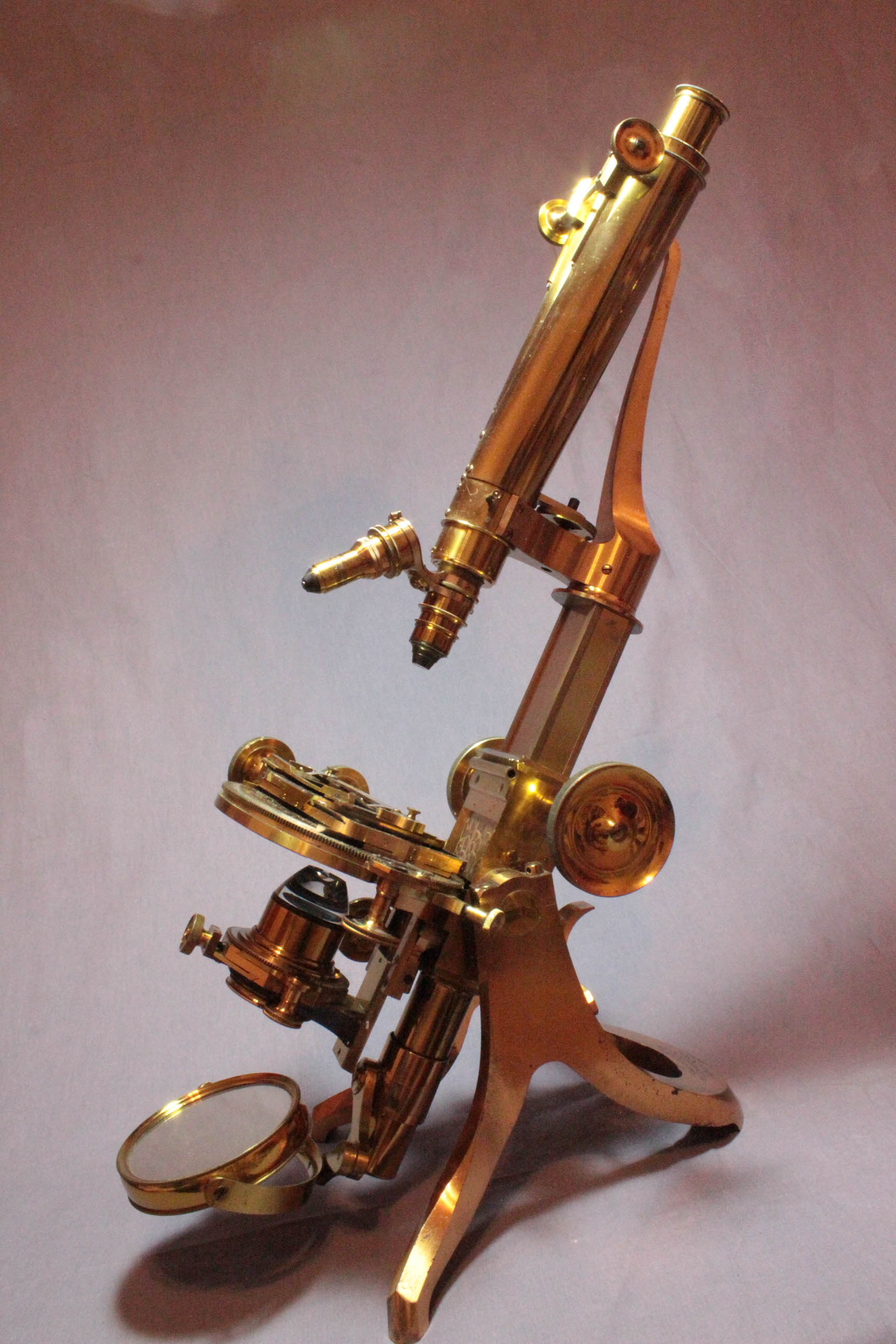 The Spot Paraboloid condenser is designed for dark ground work at low powers. It has a fixed spot painted on its inside.
The Spot Paraboloid condenser is designed for dark ground work at low powers. It has a fixed spot painted on its inside.
SWIFT DARKWELL HOLDER WITH THREE DARKWELLS:
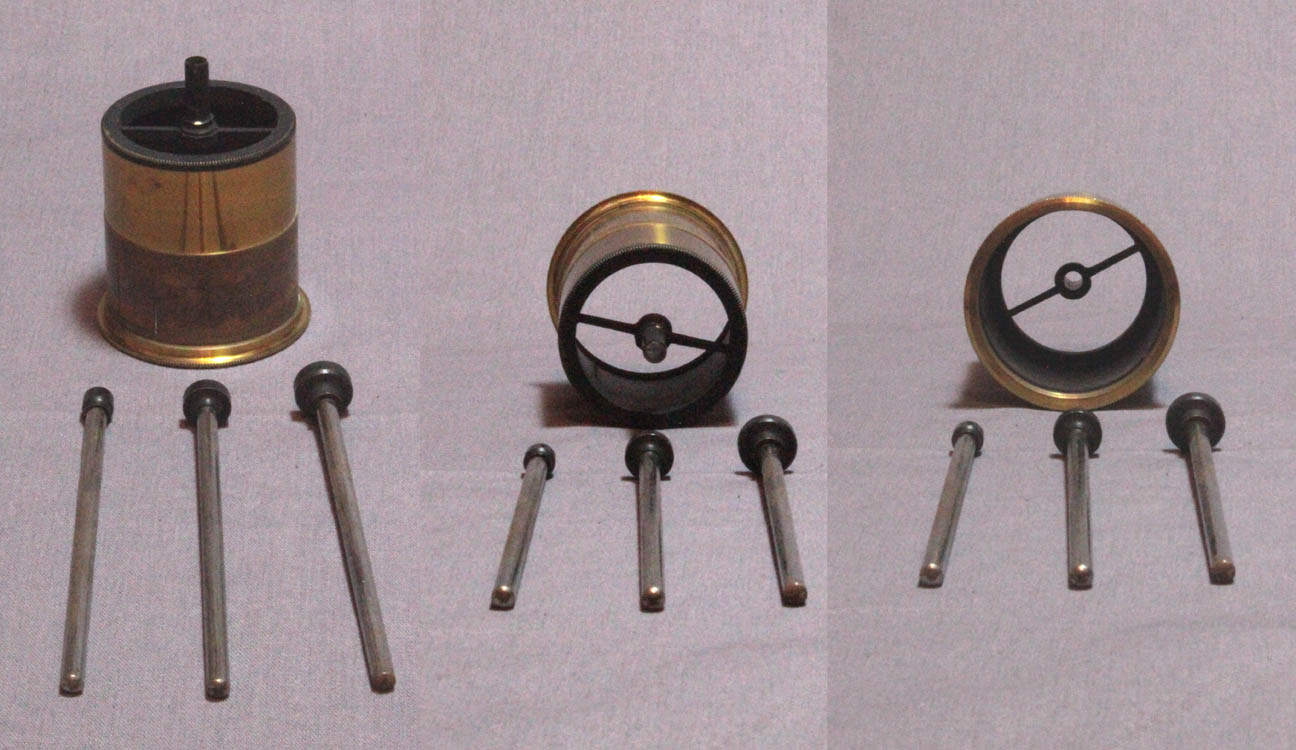
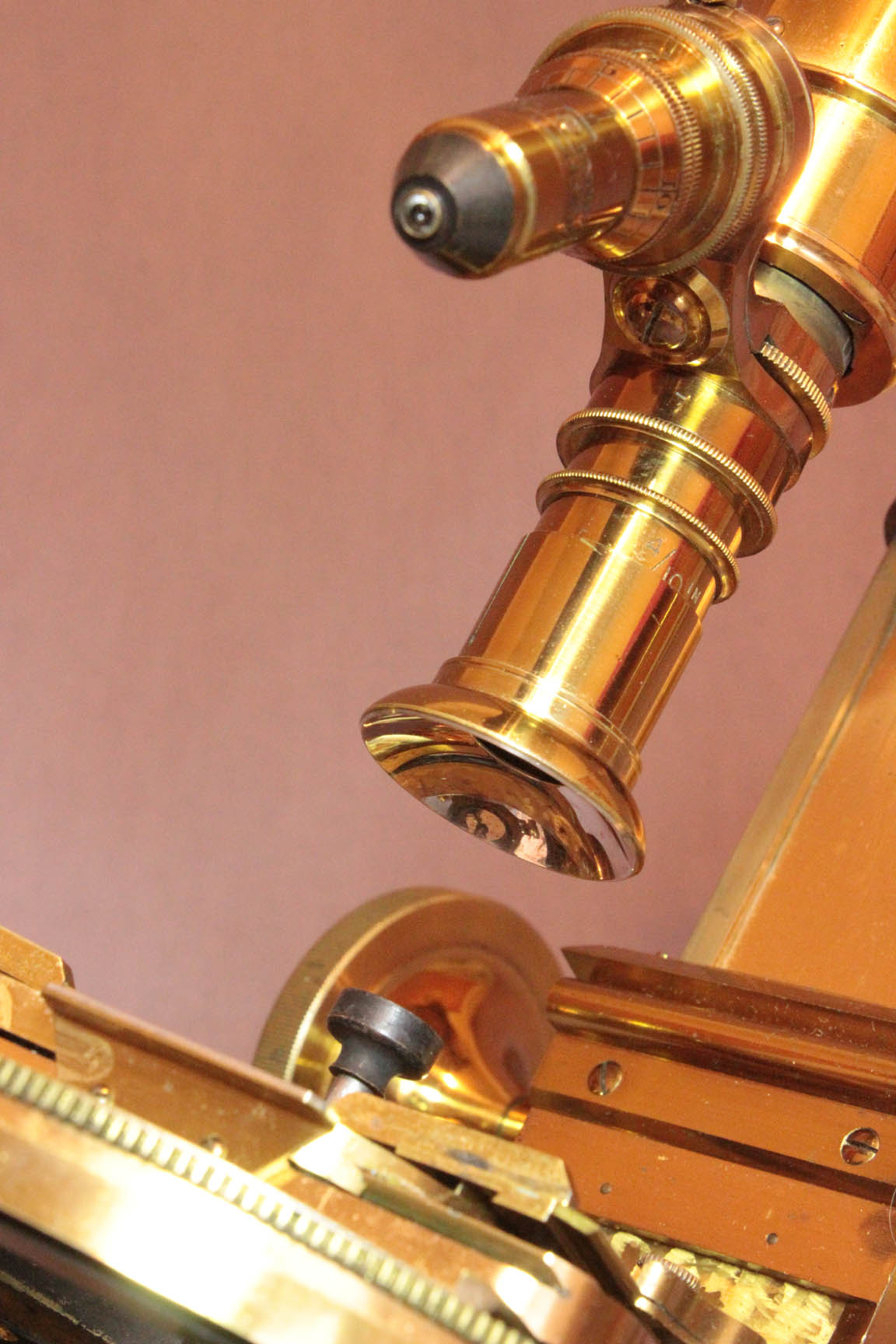 The darkwell holder accepts any of the three different diameter darkwells. These darkwells have unusually long stems. The darkwells are used with a Lieberkuhn reflector. Light reflected by the mirror up through the darkwell holder is re-directed back downward into the darkwell.
The darkwell holder accepts any of the three different diameter darkwells. These darkwells have unusually long stems. The darkwells are used with a Lieberkuhn reflector. Light reflected by the mirror up through the darkwell holder is re-directed back downward into the darkwell.
SWIFT EYEPIECES:
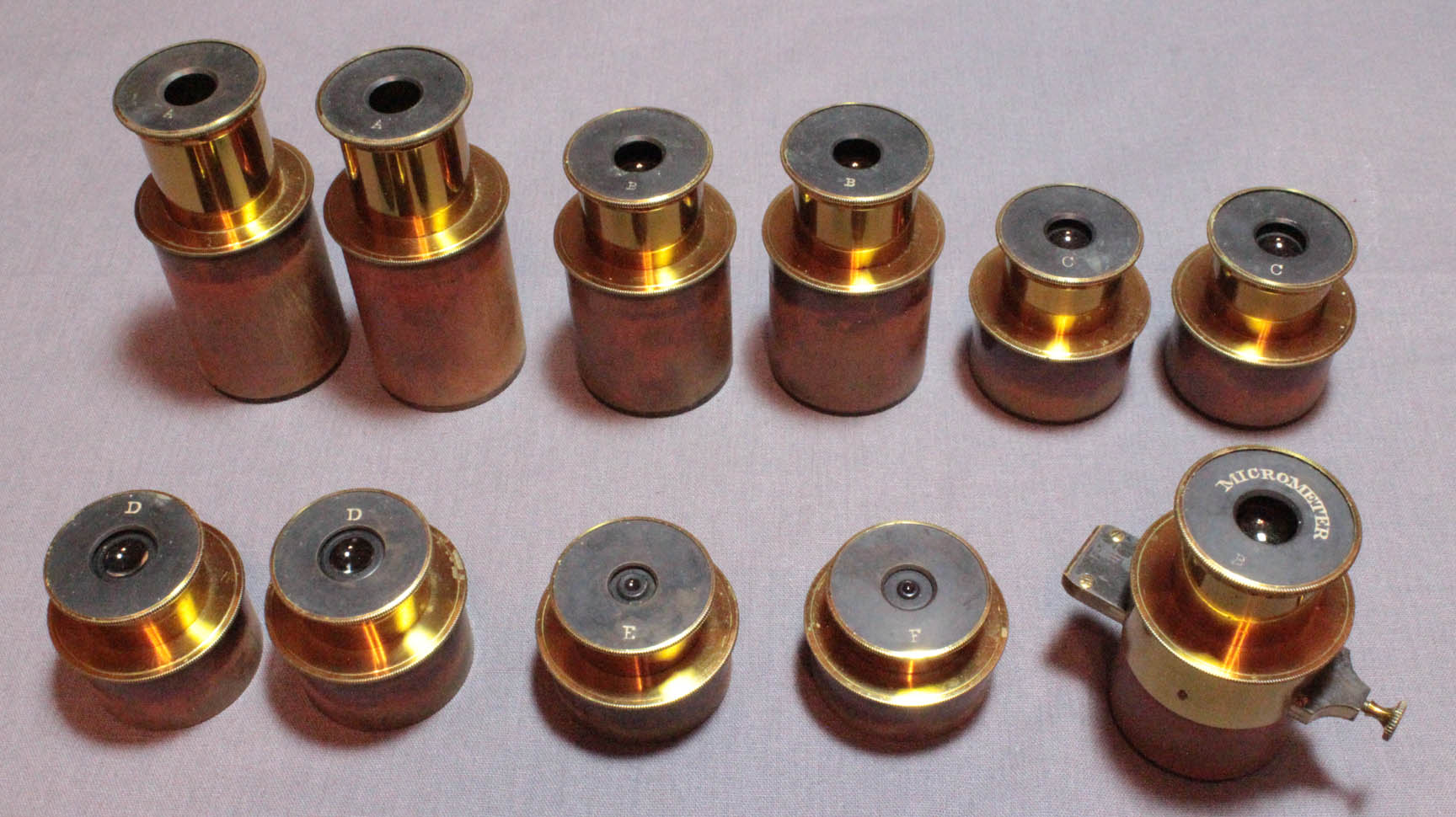 Eyepieces:
Eyepieces:
These include a pair of A,B,C and D,and one each of an E and F for higher power work. A third B eyepiece is labeled 'micrometer' and accepts through its slots the included Jackson eyepiece micrometer slider.
SWIFT WOLLASTON CAMERA LUCIDA:
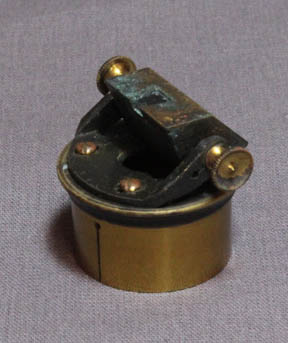
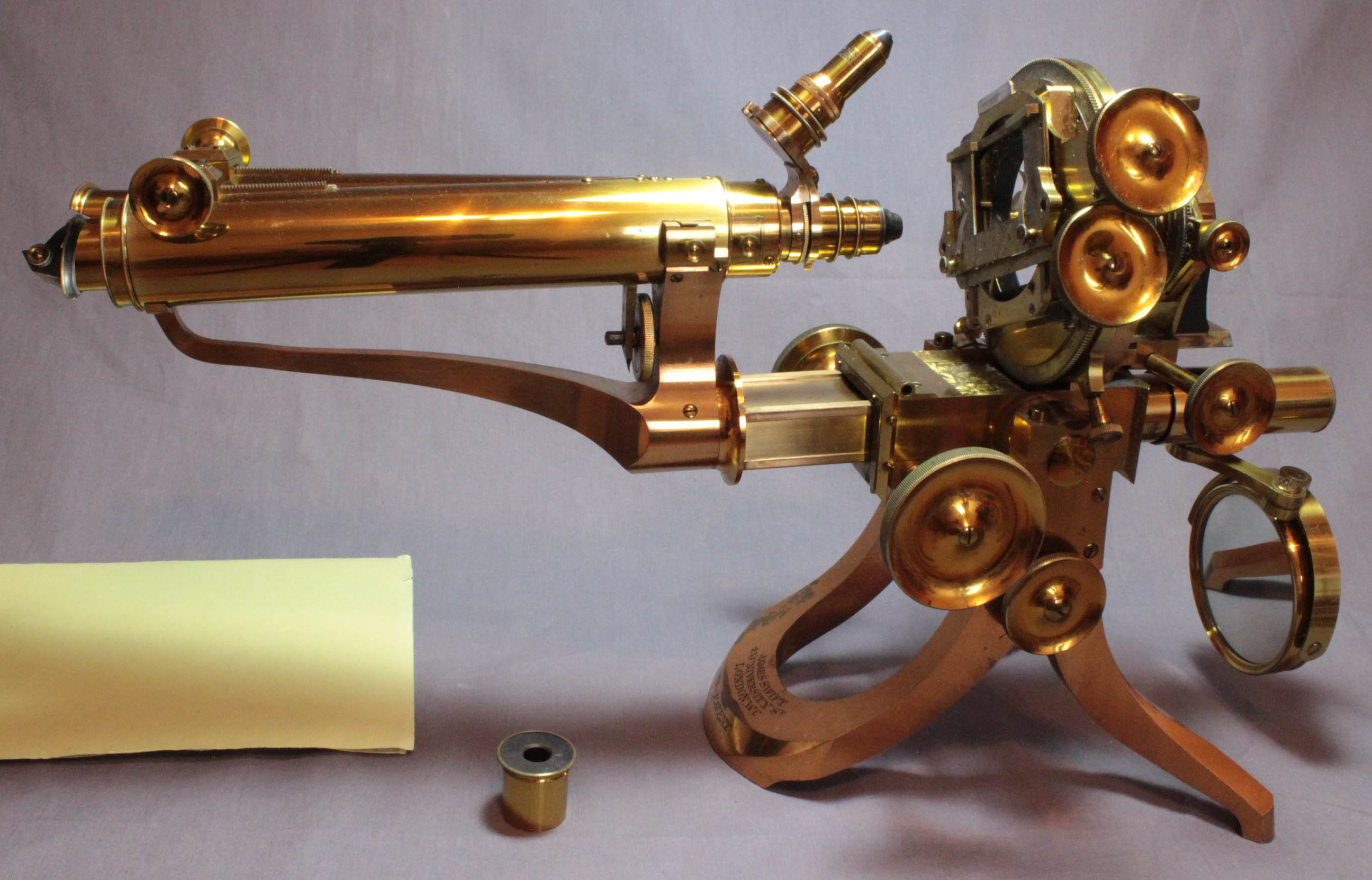 This camera lucida, shown alone to the left and on the microscope to the right, is the 'Wollaston Camera Lucida without Frames' and the second most expensive camera lucida that Swift sold in his 1870's catalogs.
This camera lucida, shown alone to the left and on the microscope to the right, is the 'Wollaston Camera Lucida without Frames' and the second most expensive camera lucida that Swift sold in his 1870's catalogs.
SWIFT OBJECTIVES:
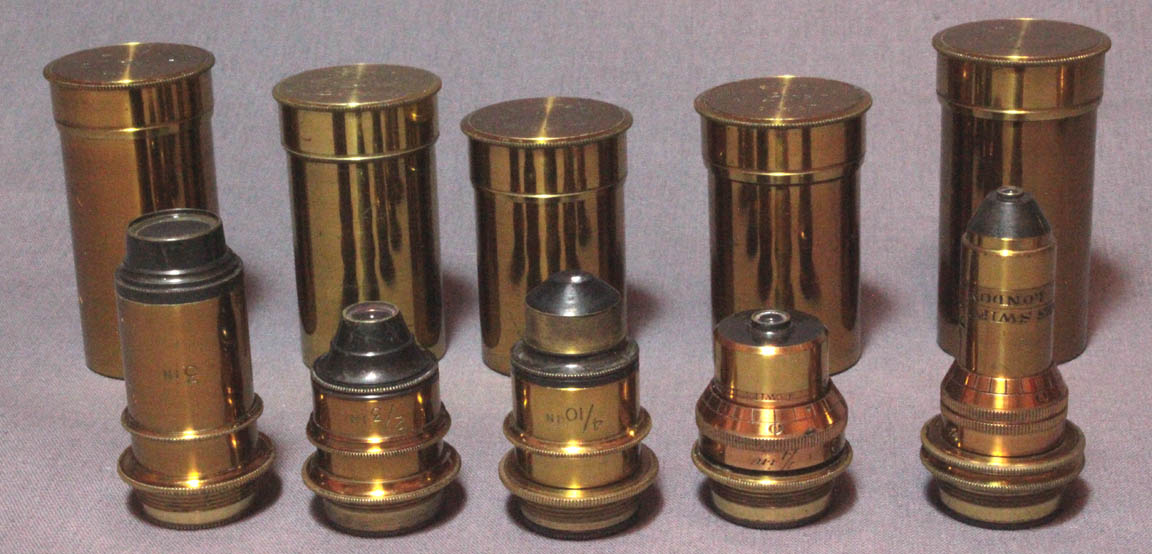 The five objectives include a 3 inch, a ⅔ inch, a 4/10 inch, a short-barelled ¼ inch with correction collar, and a ⅛ inch with correction collar, all by Swift. There is one Lieberkuhn reflector which fits all the low power objectives. All the objectives are in original cans.
The five objectives include a 3 inch, a ⅔ inch, a 4/10 inch, a short-barelled ¼ inch with correction collar, and a ⅛ inch with correction collar, all by Swift. There is one Lieberkuhn reflector which fits all the low power objectives. All the objectives are in original cans.
LIEBERKUHN REFLECTOR:
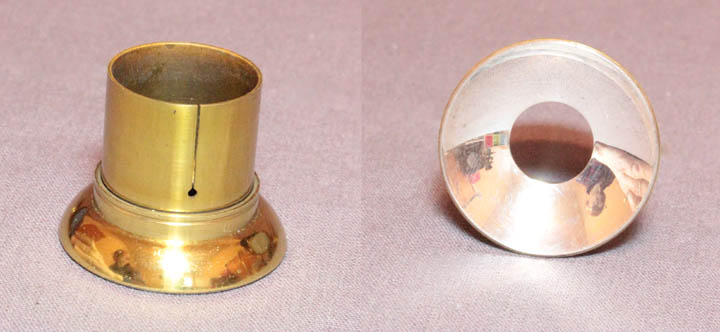
 The Lieberkuhn reflector fits any of the three lowest power objectives. It could be used to illuminate any of the darkwells or to view any small opaque object. For larger opaque objects, the Lieberkuhn cannot be used because the object would block the substage light rays, preventing them from reaching the Lieberkuhn. They would need to be illuminated by the side reflector, or one of the bullseye condensers.
The Lieberkuhn reflector fits any of the three lowest power objectives. It could be used to illuminate any of the darkwells or to view any small opaque object. For larger opaque objects, the Lieberkuhn cannot be used because the object would block the substage light rays, preventing them from reaching the Lieberkuhn. They would need to be illuminated by the side reflector, or one of the bullseye condensers.
STAGE CONDENER:
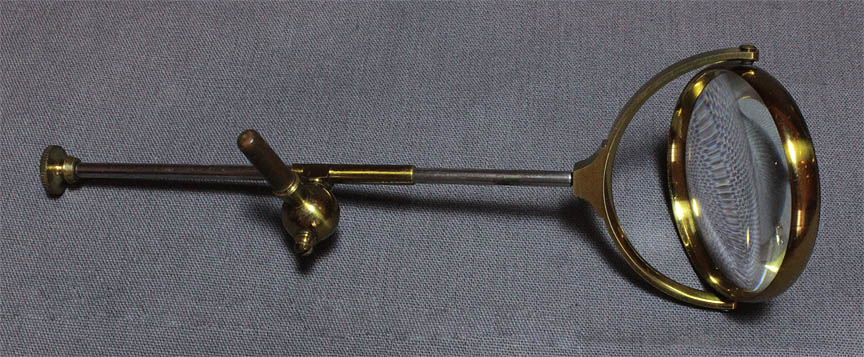
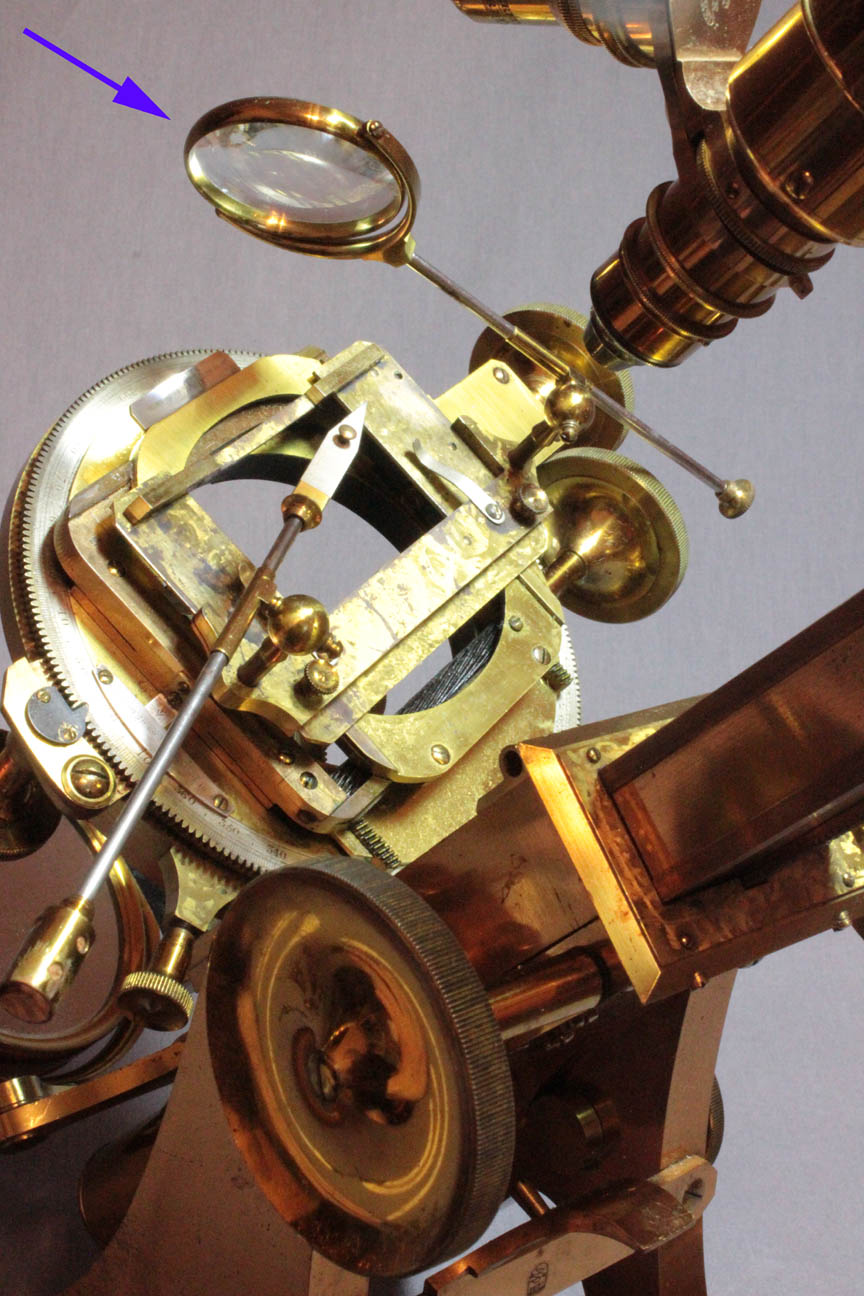 The 'Stage Condenser', shown alone to the left, and also at the blue arrow mounted for use on the stage to the right, is a bullseye condenser that attaches to the holes on either side of the moveable stage slide rest, or to either of the holes, one on each side of the limb. It is usually used in concert with another accessory such as a stage forceps as in the image to the right. It is used to concentrate light on opaque objects.
The 'Stage Condenser', shown alone to the left, and also at the blue arrow mounted for use on the stage to the right, is a bullseye condenser that attaches to the holes on either side of the moveable stage slide rest, or to either of the holes, one on each side of the limb. It is usually used in concert with another accessory such as a stage forceps as in the image to the right. It is used to concentrate light on opaque objects.
STAGE FORCEPS:

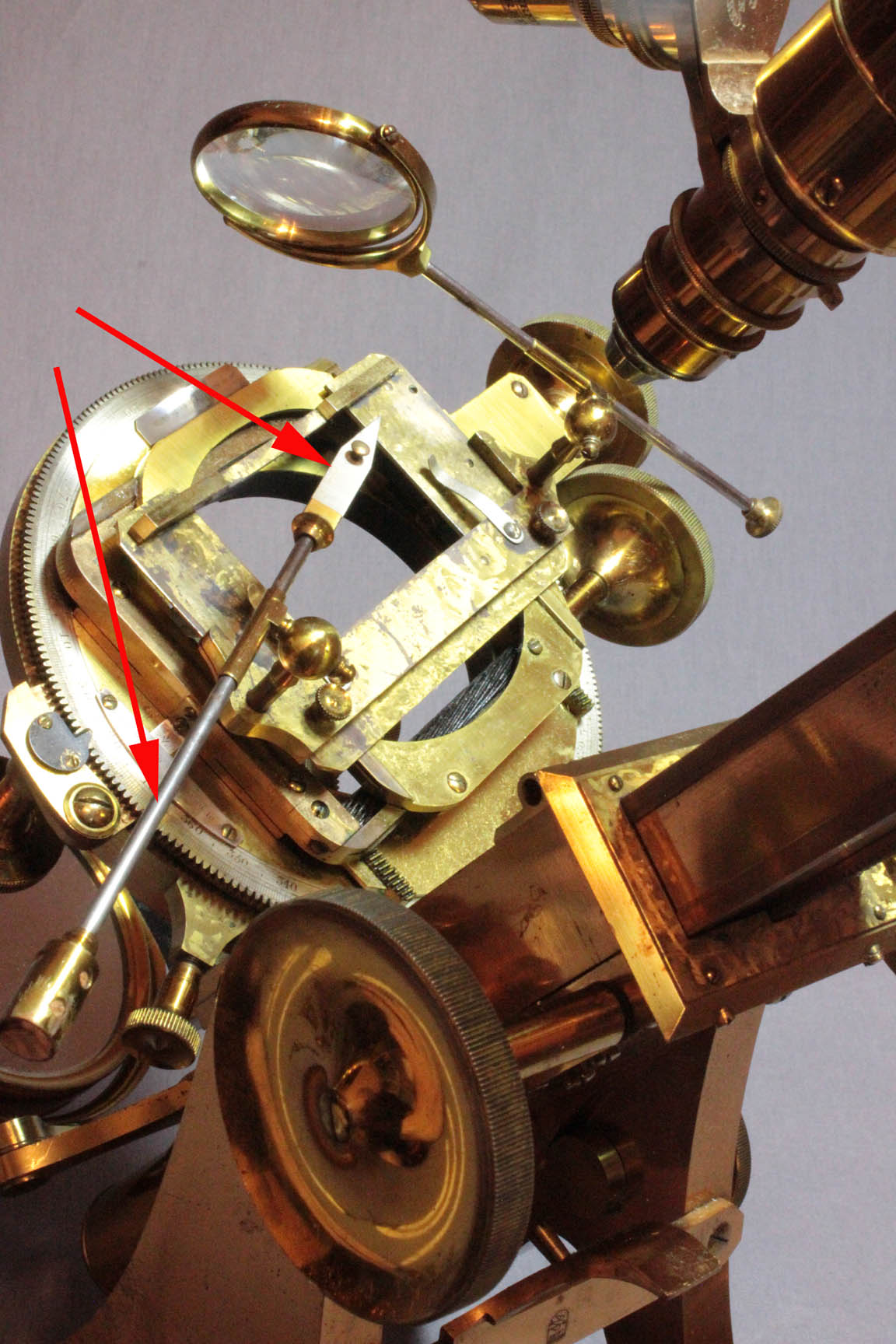 The stage forceps, shown alone to the left and on the microscope at the red arrows to the right, is a very common accessory often supplied with 19th century microscopes. This model was referred to by Swift as the 'Best Stage Forceps' and has a cork-filling casing at the opposite end from the forceps. Holes in the casing allow one to pin objects to this side. The stage forces serves to hold an opaque object like a leaf or insect. It can attach to either of the two holes on the moveable slide rest, or either of the holes, one on either side of the limb. It has two little buttons to open the spring leaf which when released, holds the object. This device works best with soft and and thin objects. Hard and/or larger objects are better held by a three pronged or 'mineral' forceps or, for small hard objects, a small 'stage vice'.
The stage forceps, shown alone to the left and on the microscope at the red arrows to the right, is a very common accessory often supplied with 19th century microscopes. This model was referred to by Swift as the 'Best Stage Forceps' and has a cork-filling casing at the opposite end from the forceps. Holes in the casing allow one to pin objects to this side. The stage forces serves to hold an opaque object like a leaf or insect. It can attach to either of the two holes on the moveable slide rest, or either of the holes, one on either side of the limb. It has two little buttons to open the spring leaf which when released, holds the object. This device works best with soft and and thin objects. Hard and/or larger objects are better held by a three pronged or 'mineral' forceps or, for small hard objects, a small 'stage vice'.
FROG PLATE:
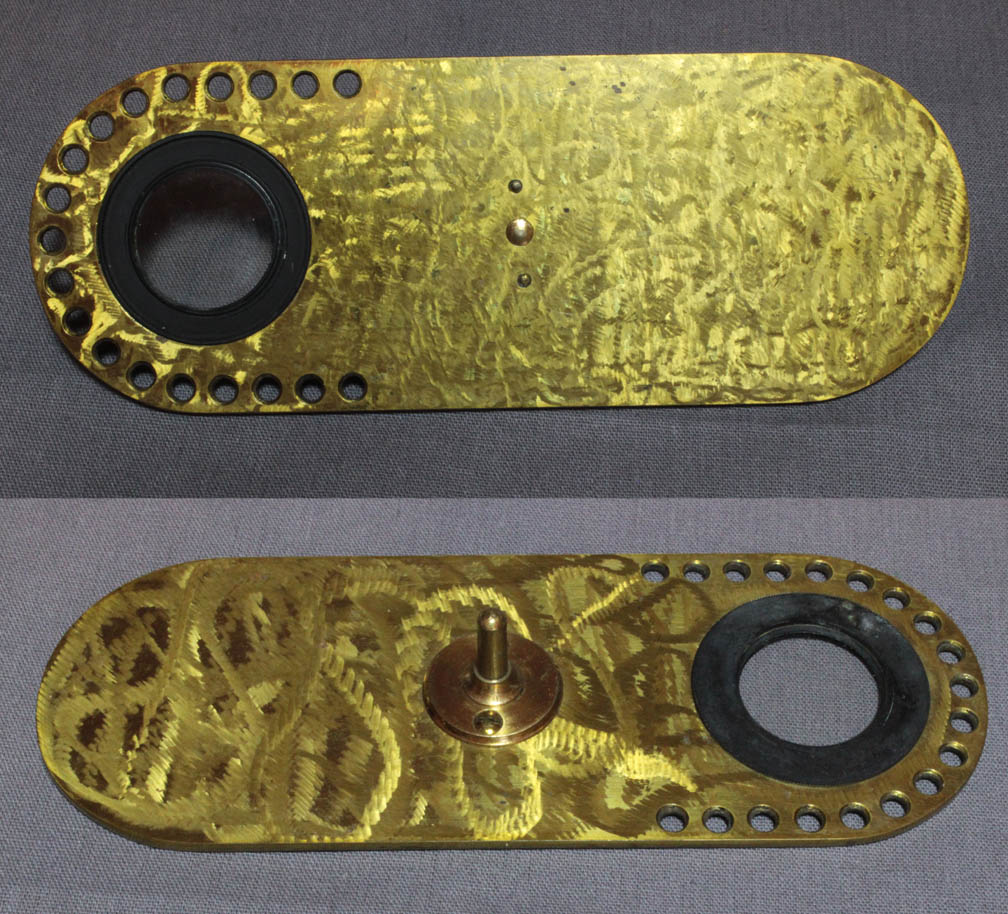
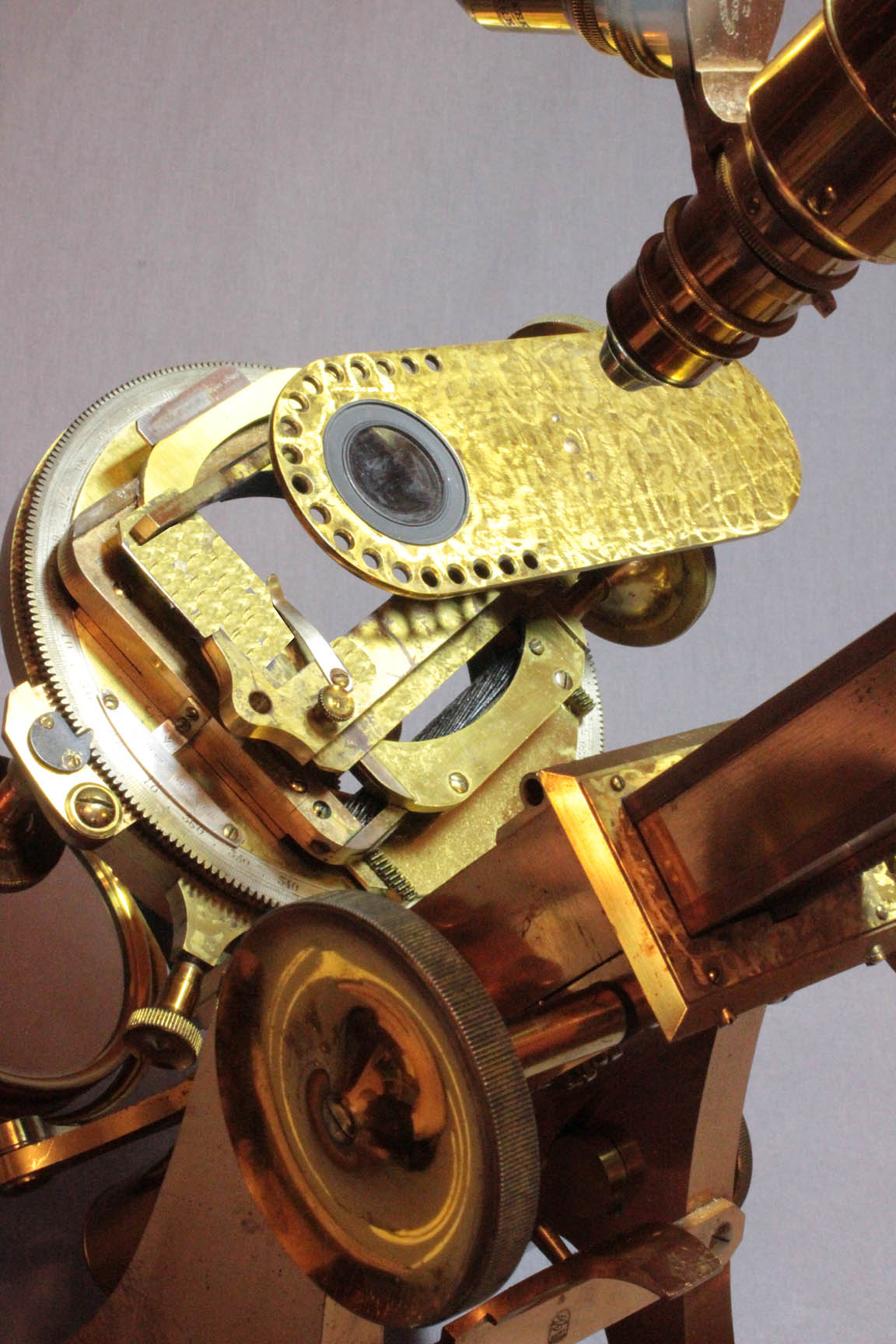 The Frogplate is shown alone to the left and attached to the moveable stage slide rest of the microscope on the right. It is a device for restraining a frog or fish to study the circulation of the blood. This is done by visualizing a relatively transparent part of the animal, namely the web foot of the frog, or the tail of a fish.
The Frogplate is shown alone to the left and attached to the moveable stage slide rest of the microscope on the right. It is a device for restraining a frog or fish to study the circulation of the blood. This is done by visualizing a relatively transparent part of the animal, namely the web foot of the frog, or the tail of a fish.
3 PRONGED or 'MINERAL' FORCEPS:
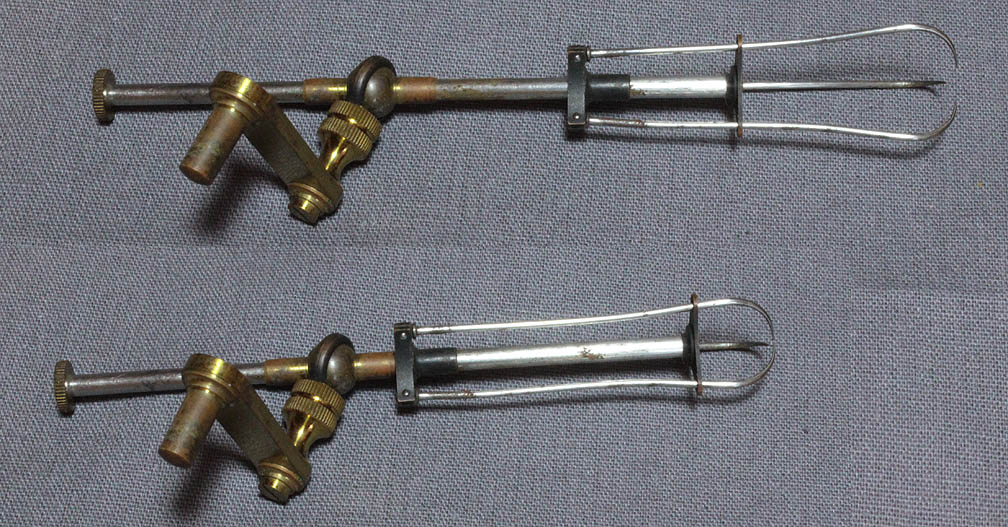
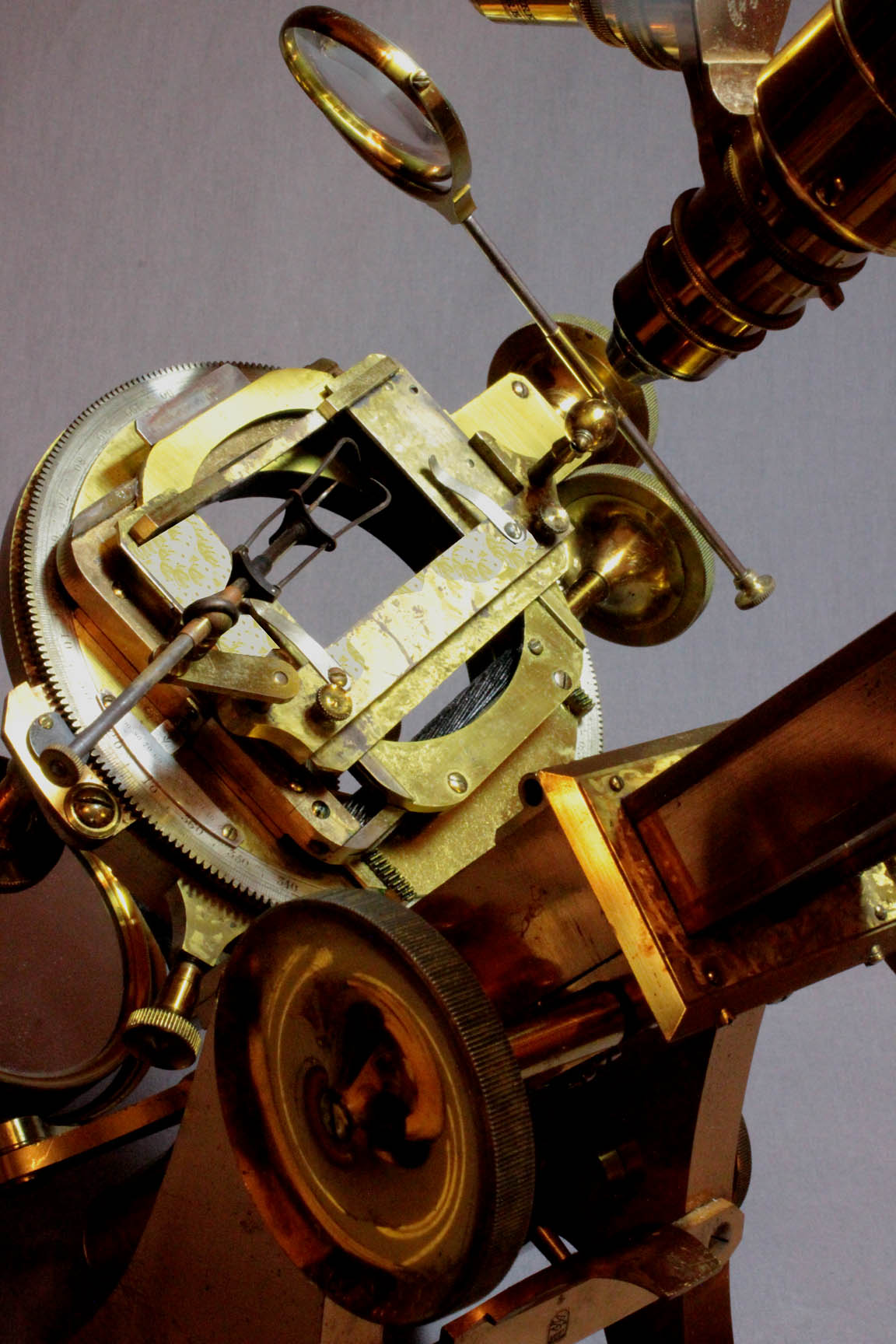 The three pronged forceps or 'Mineral Forceps' enables the user to secure an irregular specimen in the prongs of this device. It could be a rock or mineral specimen being trapped in the center, or something soft and irregular in shape, where the sharp tips of the prongs would hold it. Like the regular stage forceps, lighting from above is neccesary and could be well provided by the stage condenser or a side reflector. The device is adjustable by moving the triangular piece farthest from the sharp prong tips; forward spreads the prongs apart, and backwards brings them closer together. It can attach either to the hole on either side of the moveable stage slide rest, or to one of the side holes of the limb.
The three pronged forceps or 'Mineral Forceps' enables the user to secure an irregular specimen in the prongs of this device. It could be a rock or mineral specimen being trapped in the center, or something soft and irregular in shape, where the sharp tips of the prongs would hold it. Like the regular stage forceps, lighting from above is neccesary and could be well provided by the stage condenser or a side reflector. The device is adjustable by moving the triangular piece farthest from the sharp prong tips; forward spreads the prongs apart, and backwards brings them closer together. It can attach either to the hole on either side of the moveable stage slide rest, or to one of the side holes of the limb.
PARABOLIC SIDE REFLECTOR:
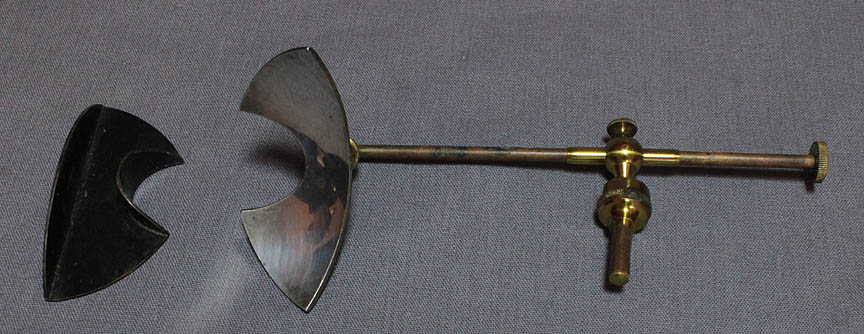
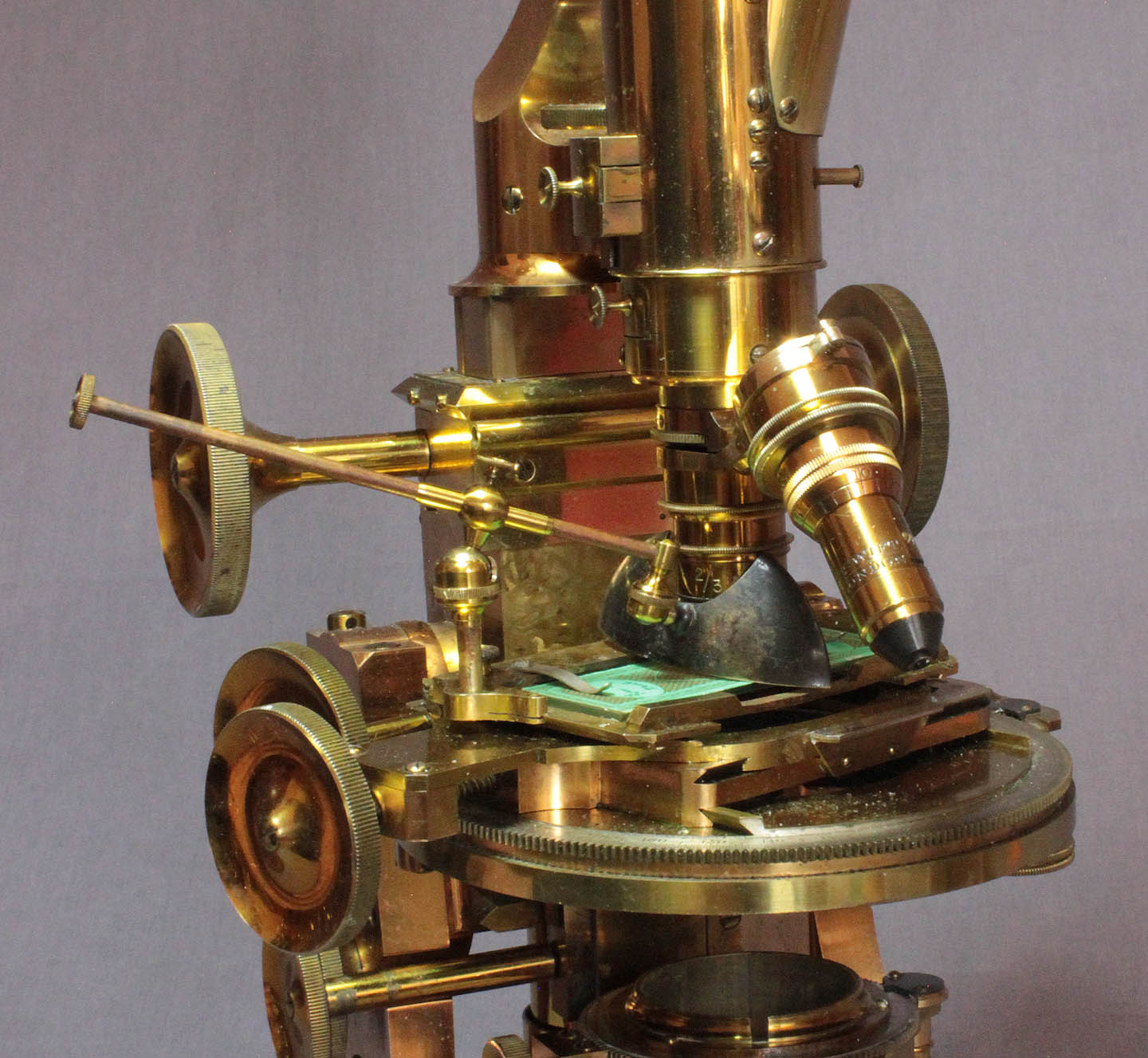 The parabolic side reflector is one method of illuminating opaque objects under relatively high power objectives, where the focal length is too short to allow sufficient lighting to be directed from the side e.g. by a bullseye condenser. This device would also fail with very high magnification objectives which require a vertical illuminator for successful illumination when observing opaque objects. The illuminator is silvered and has a blackened cap to protect the silver surface when not in use. It can attach to either of the holes on the moveable slide rest, or to one of the holes on either side of the limb.
The parabolic side reflector is one method of illuminating opaque objects under relatively high power objectives, where the focal length is too short to allow sufficient lighting to be directed from the side e.g. by a bullseye condenser. This device would also fail with very high magnification objectives which require a vertical illuminator for successful illumination when observing opaque objects. The illuminator is silvered and has a blackened cap to protect the silver surface when not in use. It can attach to either of the holes on the moveable slide rest, or to one of the holes on either side of the limb.
SWIFT'S SMALL WENHAM COMPRESSOR:
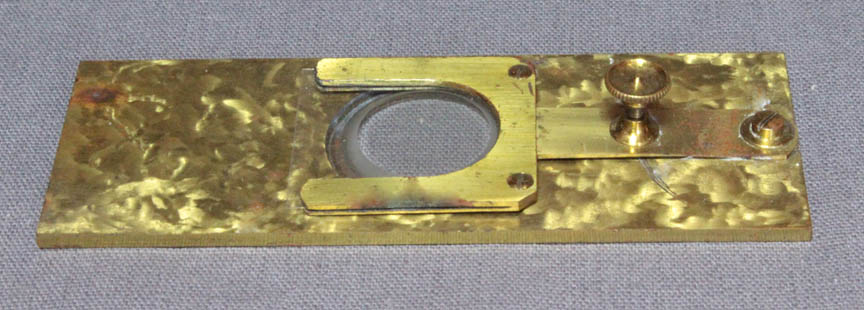 This compressor is to the design of Francis Wenham. Two different Wenham compressors were sold by Swift. This one is apparently the smaller(the larger is not illustrated in the Swift catalogs). It features a bottom glass tablet close to the stage allowing the use of the achromatic condenser and dark ground illumination. The tablet has beveled edge on the top. The small knurled knob raises the top when turned clockwise, or releases its spring action when turned counterclockwise. The top plate has a thin slit in the brass to accept a simple square cover slip.
This compressor is to the design of Francis Wenham. Two different Wenham compressors were sold by Swift. This one is apparently the smaller(the larger is not illustrated in the Swift catalogs). It features a bottom glass tablet close to the stage allowing the use of the achromatic condenser and dark ground illumination. The tablet has beveled edge on the top. The small knurled knob raises the top when turned clockwise, or releases its spring action when turned counterclockwise. The top plate has a thin slit in the brass to accept a simple square cover slip.
SWIFT'S BLANKLEY LIVEBOX:
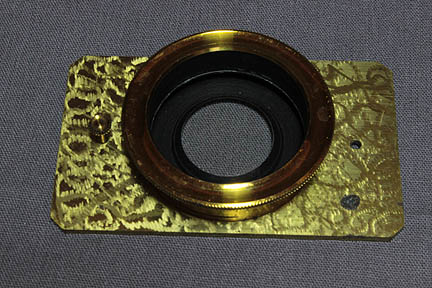 This livebox is specifically designed to allow the use of the achromatic condenser and dark ground illumination. Swift's catalogs attributed it to Blankley. It was described in the English Mechanic and World of Science No. 305, of Jan 27 1871, page 437. It is stated in the article that it was made and sold by 'Mr James Swift of 48 University Street, Tottenham-court-road and costs but a trifle more than an ordinary live-box'. This livebox very much anticipated the much later 'Rouselet livebox' of similar construction.
This livebox is specifically designed to allow the use of the achromatic condenser and dark ground illumination. Swift's catalogs attributed it to Blankley. It was described in the English Mechanic and World of Science No. 305, of Jan 27 1871, page 437. It is stated in the article that it was made and sold by 'Mr James Swift of 48 University Street, Tottenham-court-road and costs but a trifle more than an ordinary live-box'. This livebox very much anticipated the much later 'Rouselet livebox' of similar construction.
DISSECTING TOOLS:
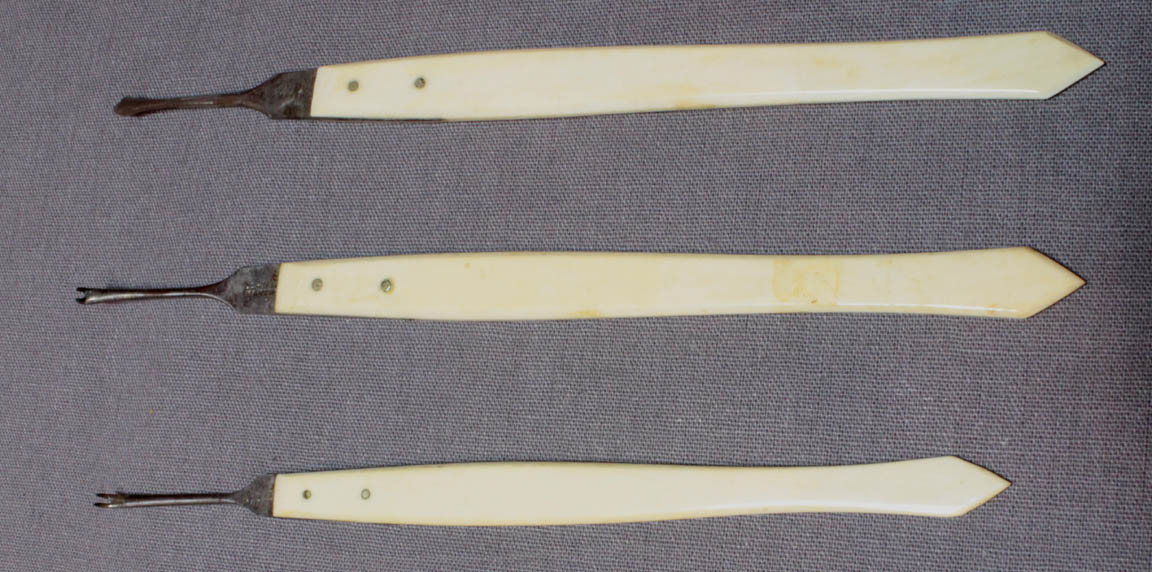
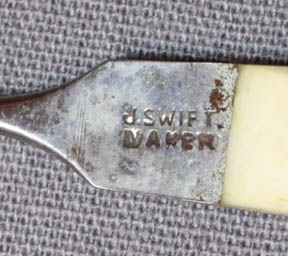 Dissecting instruments include three ivory-handled instruments. The ivory handled instruments are signed on the metal portion nearest the handles 'J SWIFT, MAKER'. They correspond to numbers 5, 6 and 9 in the 1876 and earlier catalogs.
Dissecting instruments include three ivory-handled instruments. The ivory handled instruments are signed on the metal portion nearest the handles 'J SWIFT, MAKER'. They correspond to numbers 5, 6 and 9 in the 1876 and earlier catalogs.
BRASS HAND FORCEPS:
 Among the tools included with the Swift Perry-Arm Presentation microscope is a hand held lacquered brass forceps. In some catalogs, hand forceps were referred to as 'pliers'. This is an example of the No 7 'Second Size Bottle Pliers'.
Among the tools included with the Swift Perry-Arm Presentation microscope is a hand held lacquered brass forceps. In some catalogs, hand forceps were referred to as 'pliers'. This is an example of the No 7 'Second Size Bottle Pliers'.
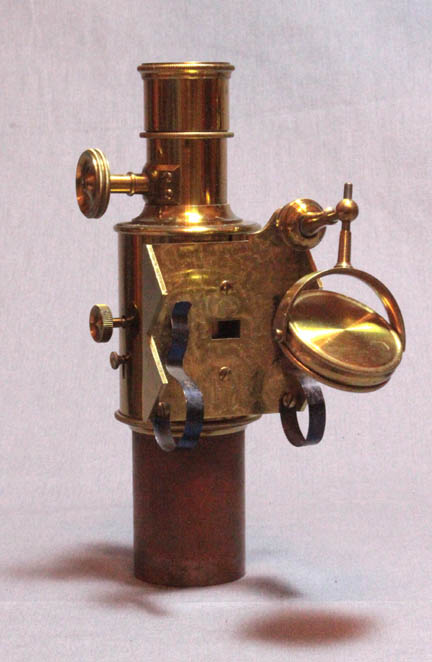 Microspectroscope:
Microspectroscope:
The outfit includes a Sorby-Browning type of microspectroscope eyepiece. It stores in the main case. It allows two spectra to be seen at the same time-the object and a reference spectra from an attached standard in a glass tube illuminated via the adjustable mirror on the side. Adjustments are provided to vary the slit openings of each set of prisms separately. Another control slides the second reference prism out the field if desired. A rack and pinion mechanism allows the user to focus on the spectra.
BENCH or 'STAND' CONDENSER: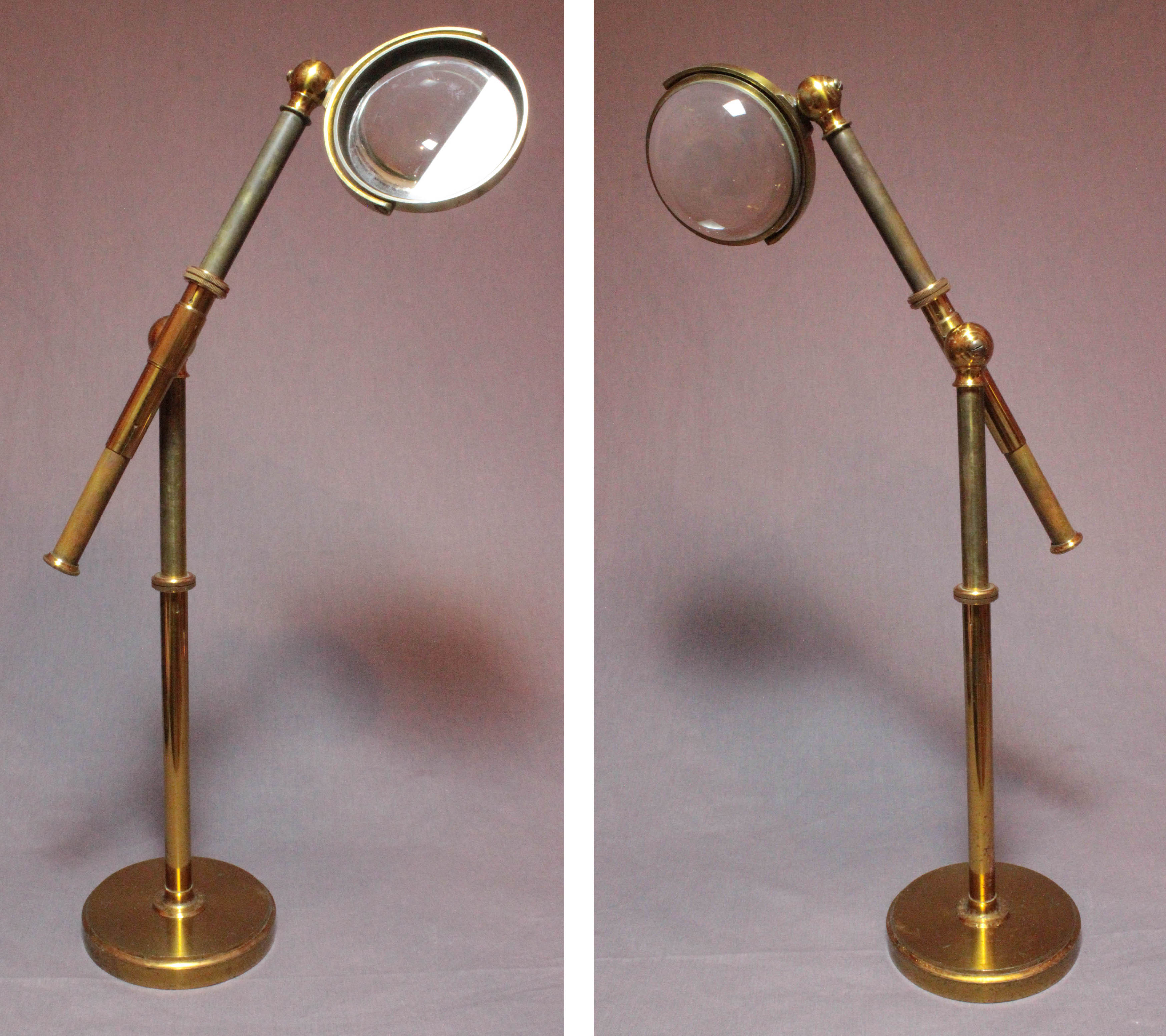 Swift offered a number of different bench condensers, but this is the largest model offered with the highest maximum height; he called it his 'Speciality Condenser'. It features a 3 inch diameter lens. It has the maximum height and most versatile adjustments of any of the bench condensers of that time period by any maker. Not only does it telescope in two different directions(vertically and at any angle for the second part), but knurled clamping knobs can hold the the two positions set. Bench condensers are used to concentrate light, and are typically used for illuminating opaque objects from above or the side. Because of the stand-alone design, adjustments will not disturb the arrangement of the microscope as much as a a stage-mounted condenser could. The round base is unscrewed and the two parts then store in the main case.
Swift offered a number of different bench condensers, but this is the largest model offered with the highest maximum height; he called it his 'Speciality Condenser'. It features a 3 inch diameter lens. It has the maximum height and most versatile adjustments of any of the bench condensers of that time period by any maker. Not only does it telescope in two different directions(vertically and at any angle for the second part), but knurled clamping knobs can hold the the two positions set. Bench condensers are used to concentrate light, and are typically used for illuminating opaque objects from above or the side. Because of the stand-alone design, adjustments will not disturb the arrangement of the microscope as much as a a stage-mounted condenser could. The round base is unscrewed and the two parts then store in the main case.
HISTORY OF THE SWIFT FIRST CLASS MICROSCOPES, THE 'CHALLENGE' MICROSCOPES, 'PRESENTATION' MICROSCOPES, AND THE 'CAPTAIN PERRY' ARM:
James Powell Swift worked for Andrew Ross until establishing his own business in 1854. Not surprisingly, his first class microscopes were initially of the bar-limb design of Ross. The microscope depicted at the top of this page, however is a modification of the standard Ross bar-limb, having a 'Captain Perry Arm'/Limb*. This modification of the bar-limb, sold only by Swift, was not described until 1874. Examples of this microscope are rather rare and this one is one of only three with such a modification sold at auction in recent years**
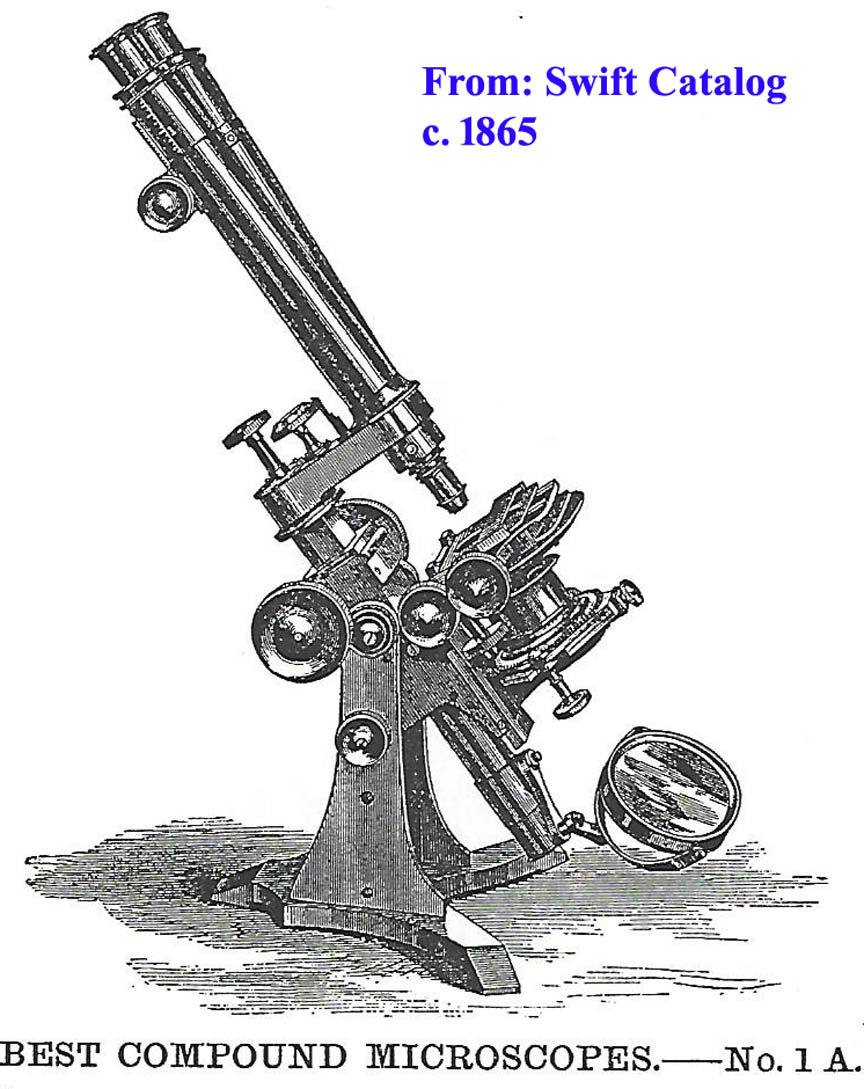 In the catalog of about 1865, from 15 Kingsland Road, all the microscopes listed were bar-limbs, likely reflecting Swift's previous association with Ross. The 'Best Compound No. 1A(left)very closely resembled the first class bar limb of Ross, complete with two uprights. The 'Presentation' binocular microscope in that catalog was described as supplied with 'milled heads of rich gun metal' and the screws were all blued steel; these blued steel screws became a feature found on many of the later Swift stands, but during this earlier period, and for many years to come, the blued screws were not a common feature. That Presentation microscope of 1865 included the centerable and rack-rotatable substage. But there was no illustration of this version of the Presentation microscope in that 1865 catalog.
In the catalog of about 1865, from 15 Kingsland Road, all the microscopes listed were bar-limbs, likely reflecting Swift's previous association with Ross. The 'Best Compound No. 1A(left)very closely resembled the first class bar limb of Ross, complete with two uprights. The 'Presentation' binocular microscope in that catalog was described as supplied with 'milled heads of rich gun metal' and the screws were all blued steel; these blued steel screws became a feature found on many of the later Swift stands, but during this earlier period, and for many years to come, the blued screws were not a common feature. That Presentation microscope of 1865 included the centerable and rack-rotatable substage. But there was no illustration of this version of the Presentation microscope in that 1865 catalog.
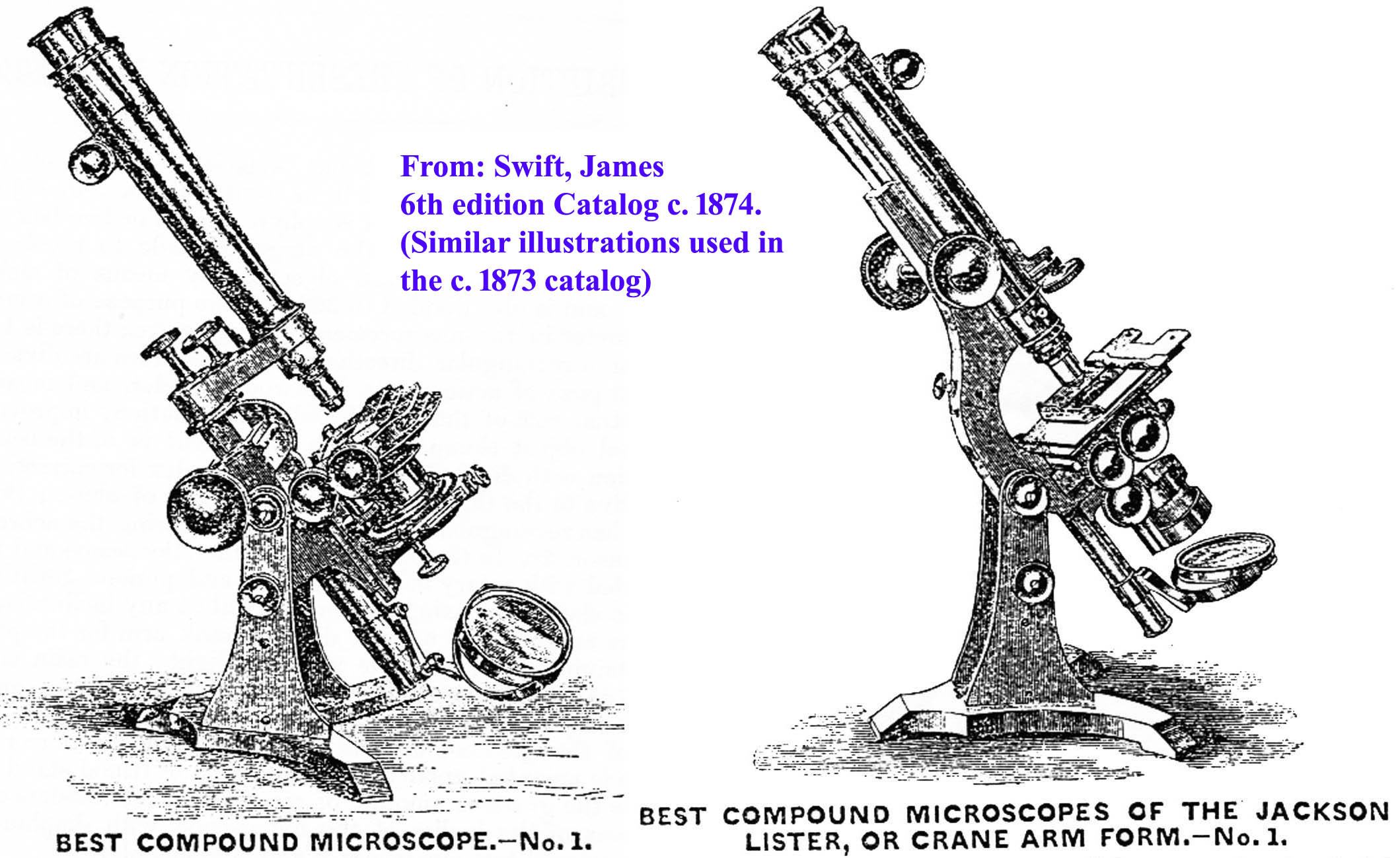 By about 1873, Swift's catalog from 43 University street contained both a 'Best Compound Microscope No. 1'(same as 1A of 1865) of bar-limb construction, and also a 'Best Compound microscope of the Jackson-Lister or 'Crane Arm' form No. 1'(both shown to the left). Both were still supported by uprights as in the original Ross design for his Bar Limbs. During this time though, a much more expensive Presentation Microscope was offered made of 'German Silver and rich Gun metal heads' also with the blued steel screws. This cost a whopping £80 or twice the price of the first class stands. Again, only a description, and no illustration was provided for this more ostentatious Presentation model.
By about 1873, Swift's catalog from 43 University street contained both a 'Best Compound Microscope No. 1'(same as 1A of 1865) of bar-limb construction, and also a 'Best Compound microscope of the Jackson-Lister or 'Crane Arm' form No. 1'(both shown to the left). Both were still supported by uprights as in the original Ross design for his Bar Limbs. During this time though, a much more expensive Presentation Microscope was offered made of 'German Silver and rich Gun metal heads' also with the blued steel screws. This cost a whopping £80 or twice the price of the first class stands. Again, only a description, and no illustration was provided for this more ostentatious Presentation model.
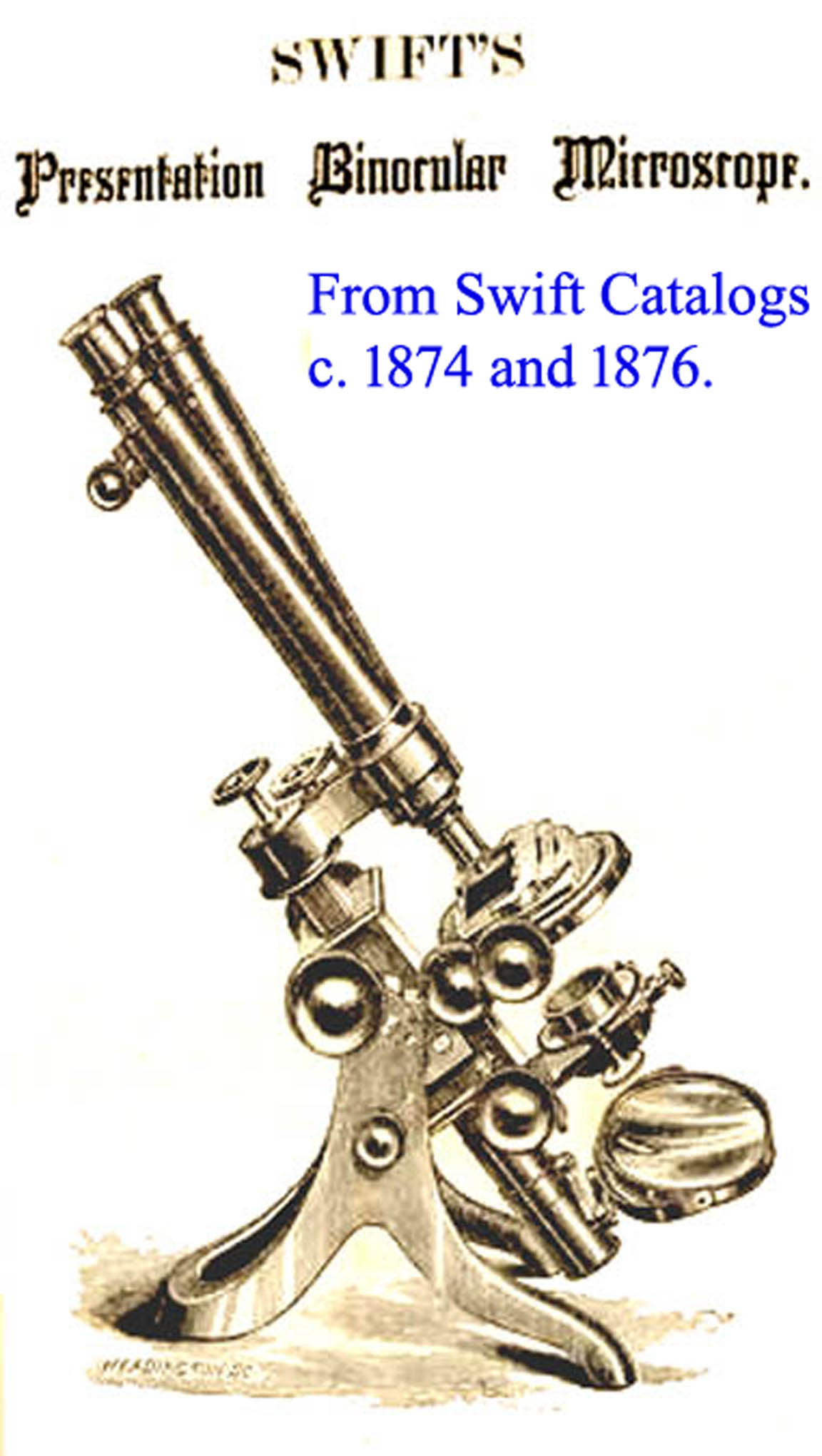 As stated in the 6th edition catalog of about 1874, the Presentation microscope was once again a lacquered brass model costing £40 but now with the new bent type of Swift tripod stand. The Best compound No. 1 (the same as 1A of 1865 and No. 1 of the catalog of about 1873), both the bar limb and the Jackson-Lister limb, remained atop the two uprights.
As stated in the 6th edition catalog of about 1874, the Presentation microscope was once again a lacquered brass model costing £40 but now with the new bent type of Swift tripod stand. The Best compound No. 1 (the same as 1A of 1865 and No. 1 of the catalog of about 1873), both the bar limb and the Jackson-Lister limb, remained atop the two uprights.
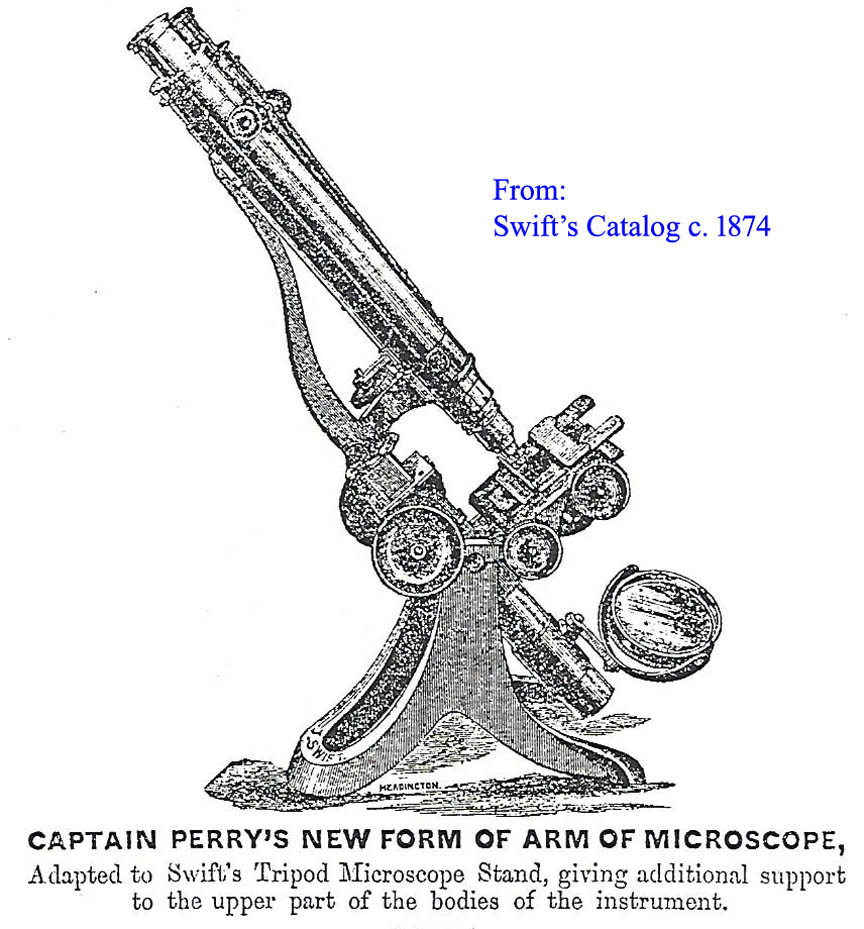 Also new in the c. 1874 catalog, on page 11, was 'Captain Perry's New Form of Arm of Microscope' which featured the sculptural support arising from the arm to support the top of the right binocular tube. This microscope was offered with four options including the monocular, the binocular, with an analyser added above the binocular prism, a goniometer stage, and the rack & pinion substage added to all the above for a total cost of about £43, about £3 above the price of the Presentation model. This could then be a 'Perry-arm Presentation microscope', though not called that in the catalog of 1874.
Also new in the c. 1874 catalog, on page 11, was 'Captain Perry's New Form of Arm of Microscope' which featured the sculptural support arising from the arm to support the top of the right binocular tube. This microscope was offered with four options including the monocular, the binocular, with an analyser added above the binocular prism, a goniometer stage, and the rack & pinion substage added to all the above for a total cost of about £43, about £3 above the price of the Presentation model. This could then be a 'Perry-arm Presentation microscope', though not called that in the catalog of 1874.
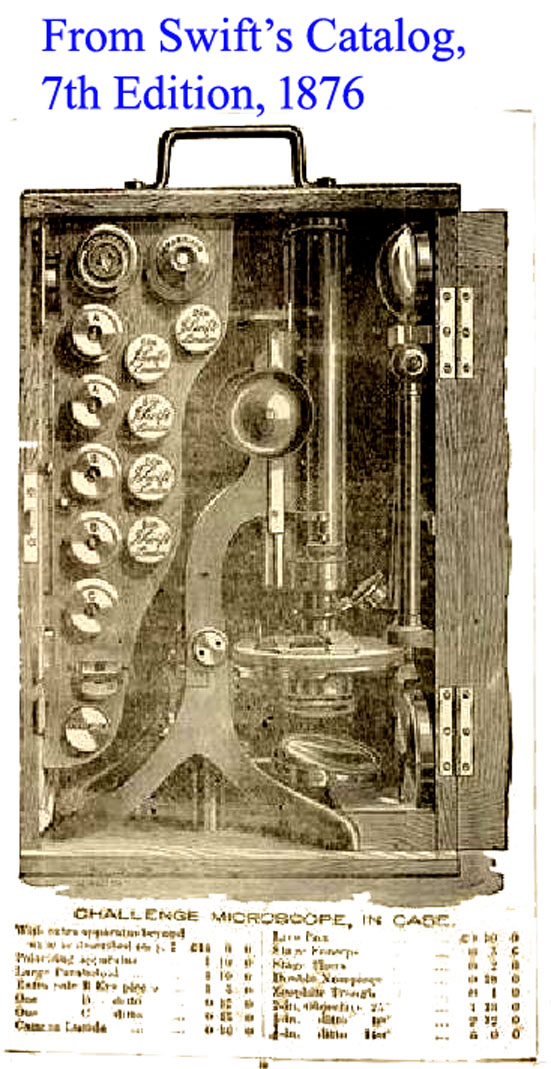 In the 7th Edition of Swift's catalog of 1876, the 'Presentation' microscope was the same as in the 6th edition. However it is in the 7th edition of 1876 that a microscope is labeled as the 'Challenge' and this version was later to become the lowest class of the Challenge series, the 'Challenge A'. Unfortunately, I do not have access to a full copy of the 1876 catalog, only a few pages.
In the 7th Edition of Swift's catalog of 1876, the 'Presentation' microscope was the same as in the 6th edition. However it is in the 7th edition of 1876 that a microscope is labeled as the 'Challenge' and this version was later to become the lowest class of the Challenge series, the 'Challenge A'. Unfortunately, I do not have access to a full copy of the 1876 catalog, only a few pages.
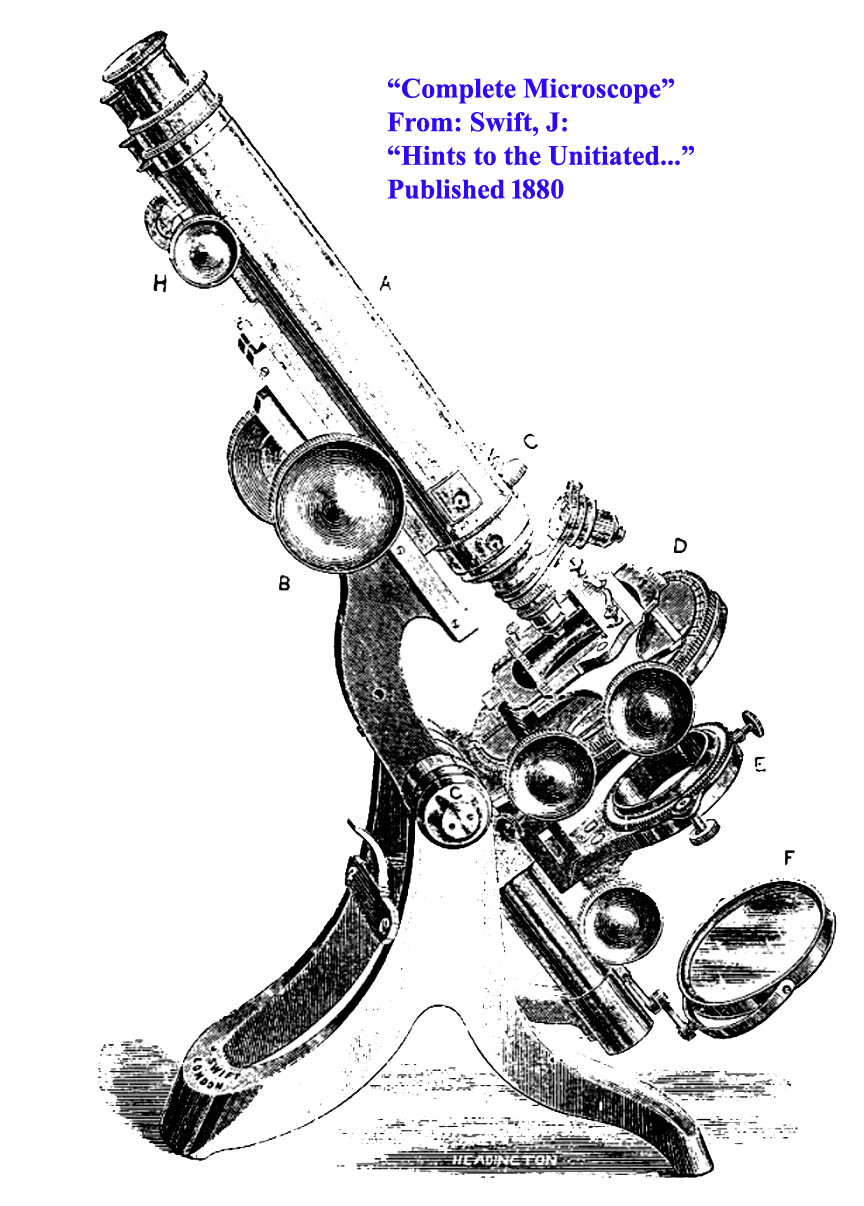 In his 1880 publication Hints to the Uninitiated..., Swift pictures a 'Complete microscope' which is actually the 'Best Challenge' model referred to later, but with a short lever nosepiece fine adjustment instead of the later side fine adjustment.
In his 1880 publication Hints to the Uninitiated..., Swift pictures a 'Complete microscope' which is actually the 'Best Challenge' model referred to later, but with a short lever nosepiece fine adjustment instead of the later side fine adjustment.
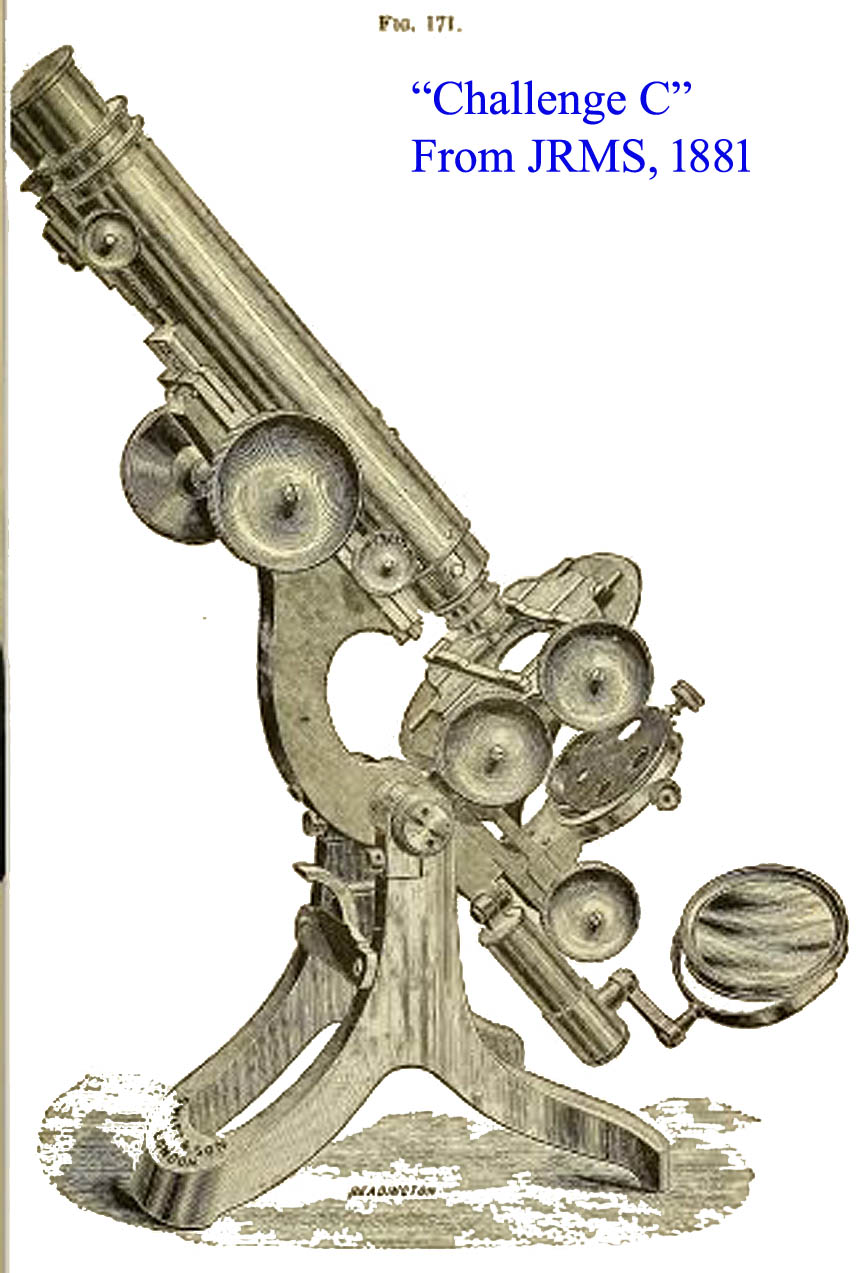 In the JRMS of 1881 the 'Challenge C' was pictured to show that the fine adjustment had changed to the side adjusted version. It is clear that the use of the term 'Challenge' to describe this series of microscopes had been adapted before 1881. As noted above, this term was first used in a Swift catalog in 1876.
In the JRMS of 1881 the 'Challenge C' was pictured to show that the fine adjustment had changed to the side adjusted version. It is clear that the use of the term 'Challenge' to describe this series of microscopes had been adapted before 1881. As noted above, this term was first used in a Swift catalog in 1876.
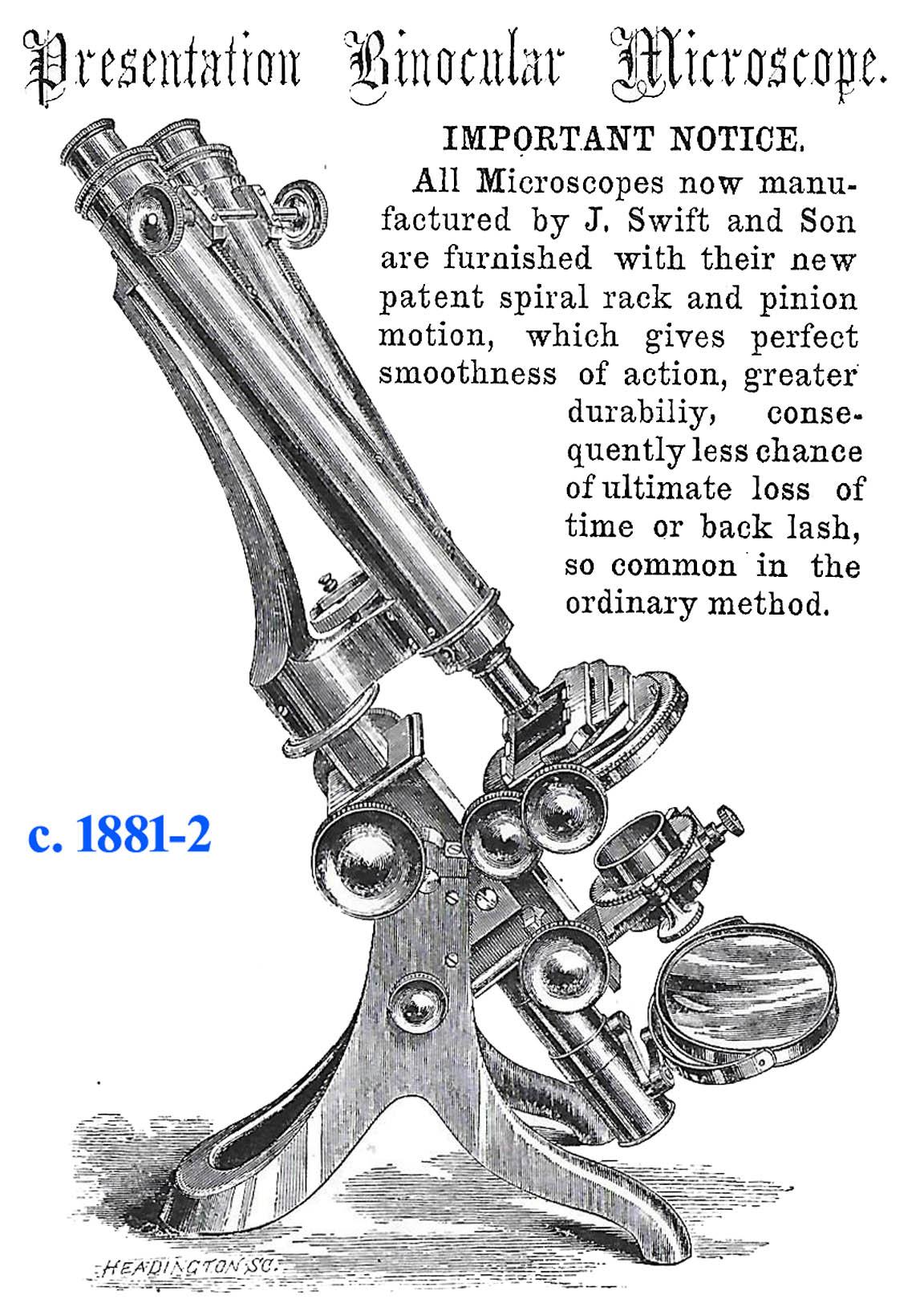
 In a catalog from about 1881-2, from the Tottenham address, the engraving of the 'Swift Binocular Presentation Microscope' is shown to the right. This is the only engraving the author has found clearly showing a Perry-Arm bar-limb Presentation model; it had a caption below it, appologizing for using this engraving, noting that this model was no longer going to be the form of the Presentation Model from that time forward. Indeed this was true by 1883 when the engraving showed the Presentation model as a Lister Limb type, as shown in the next paragraph.
In a catalog from about 1881-2, from the Tottenham address, the engraving of the 'Swift Binocular Presentation Microscope' is shown to the right. This is the only engraving the author has found clearly showing a Perry-Arm bar-limb Presentation model; it had a caption below it, appologizing for using this engraving, noting that this model was no longer going to be the form of the Presentation Model from that time forward. Indeed this was true by 1883 when the engraving showed the Presentation model as a Lister Limb type, as shown in the next paragraph.
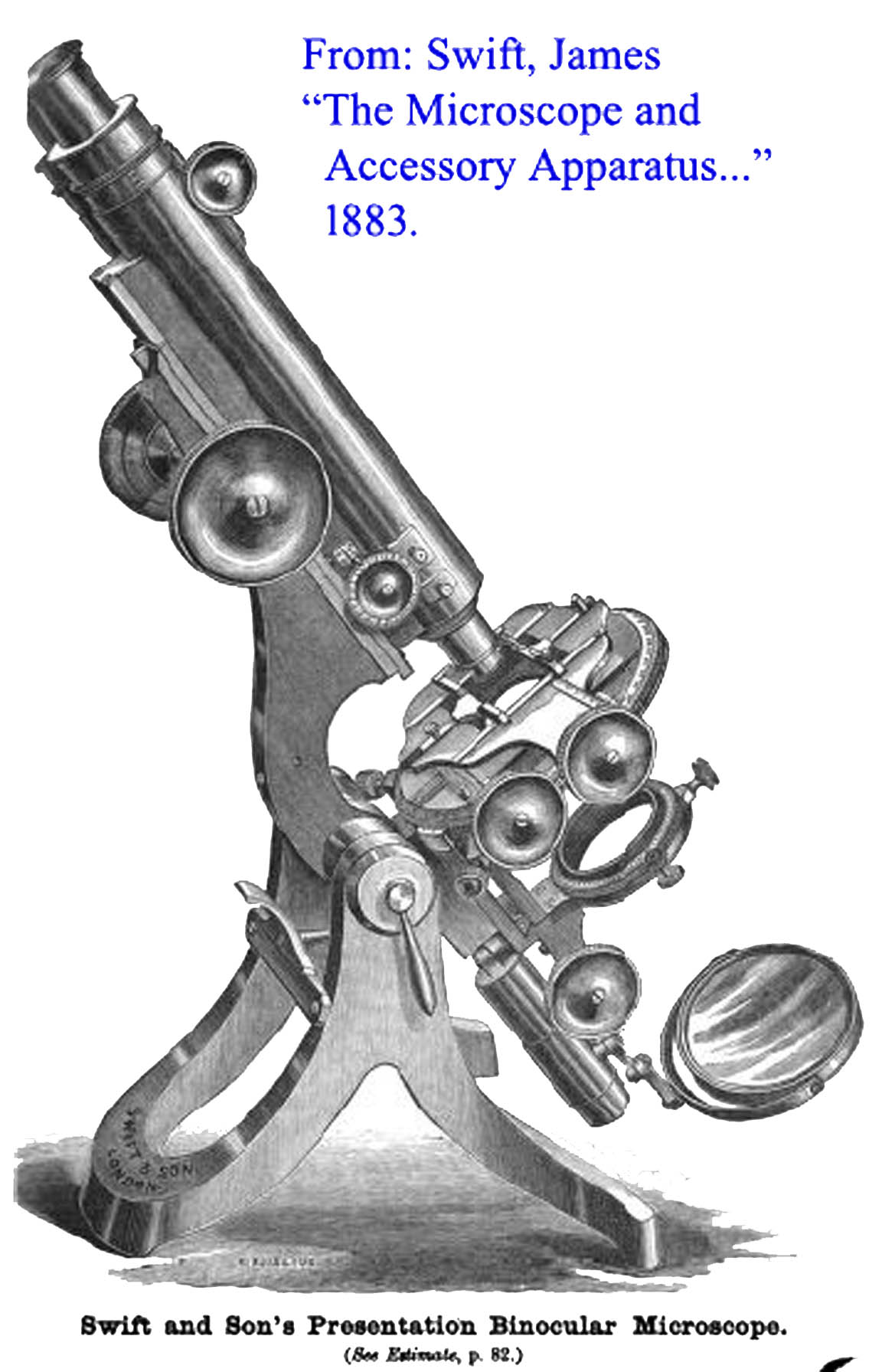 In his longer book, The Microscope and Accessory Apparatus..., published in 1883, the same engraving, i.e. the 'Best Challenge' is now referred to as the 'First Class Compound Binocular Microscope'. The only microscope in this publication referred to as a Challenge is actually the 'Challenge A', the simplest form of the Challenge.
Also in this book of 1883, is pictured the version of the 'Presentation' Microscope' which would be found unchanged from that time forward, until at least 1901. Of lacquered brass, and slightly larger than the 'Best Challenge' The main difference between the two, other than size, was the 'Presentation' had the 'Climax' side fine adjustment. But this fine adjustment was also supplied with the 'Best Challenge no later than 1892
In his longer book, The Microscope and Accessory Apparatus..., published in 1883, the same engraving, i.e. the 'Best Challenge' is now referred to as the 'First Class Compound Binocular Microscope'. The only microscope in this publication referred to as a Challenge is actually the 'Challenge A', the simplest form of the Challenge.
Also in this book of 1883, is pictured the version of the 'Presentation' Microscope' which would be found unchanged from that time forward, until at least 1901. Of lacquered brass, and slightly larger than the 'Best Challenge' The main difference between the two, other than size, was the 'Presentation' had the 'Climax' side fine adjustment. But this fine adjustment was also supplied with the 'Best Challenge no later than 1892
The later catalogs, including the 1892 catalog and the 1901 catalog refer to the 'Large Presentation', 'Best Challenge', the 'Challenge C', 'Challenge B', and 'Challenge A', in decreasing order of sophistication. The 'Large Presentation Microscope' in these publications is simply a slightly larger version of the 'Best Challenge' with a slightly more curved limb which has a longer attachment to the body tube, and a clamp directly to the inclination joint. By this time, the clutch mechanism, as seen on the microscope featured at the top of this web page, used for many years to tighten the inclination joint, controlled by a knob below the inclination joint itself, was no longer used. Even the 'Best Challenge' of 1892 had no clutch, but instead had the more familiar fitting on the end of the inclination joint itself, with two holes, tightened with a brass bar fitted with pins of appropriate proportions and spacing(today we would call this tool a spanner wrench). Now the 'Large Presentation Microscope' had a handle directly built-in to the tightening nut of the inclination joint. 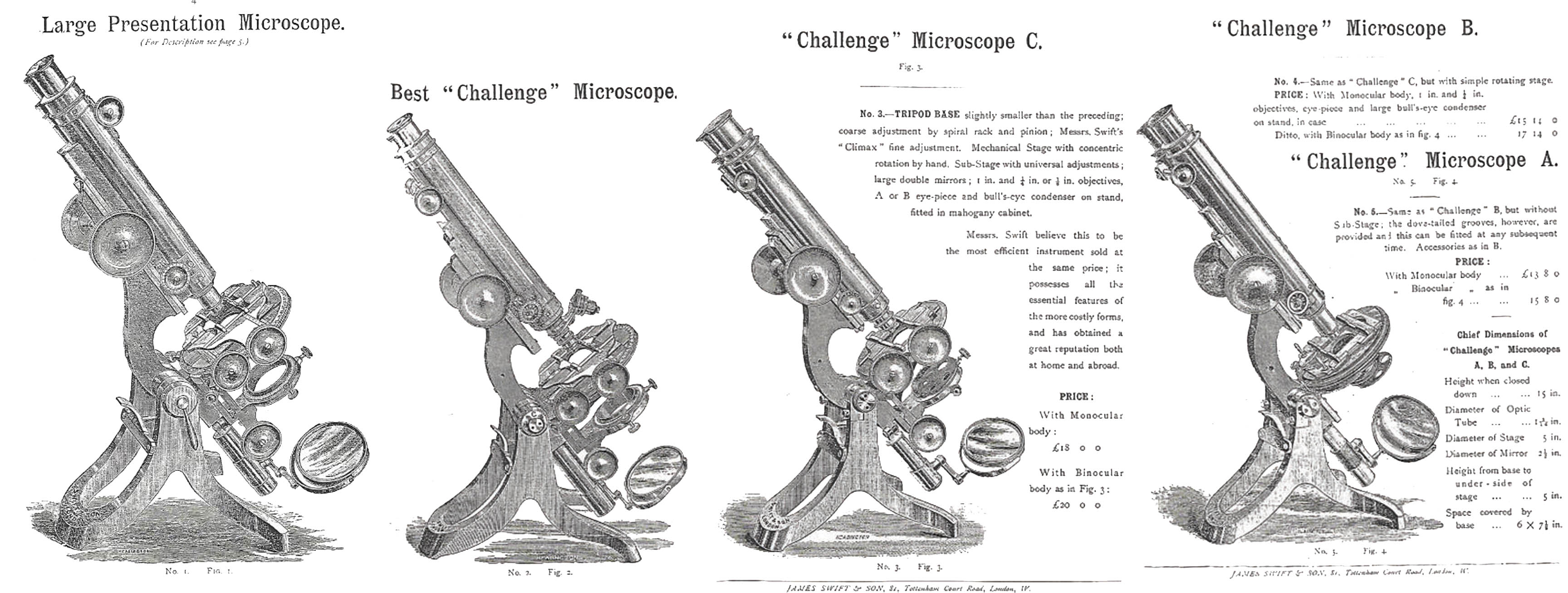 The above images illustrate the differences in the fully developed Presentation and Challenge microscope series, as illustrated in the 1892 catalog. The Presentation model was slightly larger than the 'Best Challenge' but was otherwise similar. Both had mechanical stages with geared rotation, rack and pinion centerable substages, etc. Besides the slightly larger size, the Presentation microscope had a built in handle to adjust the tension of the inclination joint, whereas all the Challenge microscopes required the use of an adjustment tool, as described above, to do this. The Challenge C, B and A were apparently all about the same size. The C model differed from the Best Challenge in being slightly smaller and having only manual rotation to the stage without gearing. The B model was the same but had no rack and pinion substage; instead it had provision for substage apparatus under the stage. The A model was the same as the B without a substage apparatus, but with a dovetail under the stage to accept such later. All were available in monocular or binocular forms.
The above images illustrate the differences in the fully developed Presentation and Challenge microscope series, as illustrated in the 1892 catalog. The Presentation model was slightly larger than the 'Best Challenge' but was otherwise similar. Both had mechanical stages with geared rotation, rack and pinion centerable substages, etc. Besides the slightly larger size, the Presentation microscope had a built in handle to adjust the tension of the inclination joint, whereas all the Challenge microscopes required the use of an adjustment tool, as described above, to do this. The Challenge C, B and A were apparently all about the same size. The C model differed from the Best Challenge in being slightly smaller and having only manual rotation to the stage without gearing. The B model was the same but had no rack and pinion substage; instead it had provision for substage apparatus under the stage. The A model was the same as the B without a substage apparatus, but with a dovetail under the stage to accept such later. All were available in monocular or binocular forms.
. 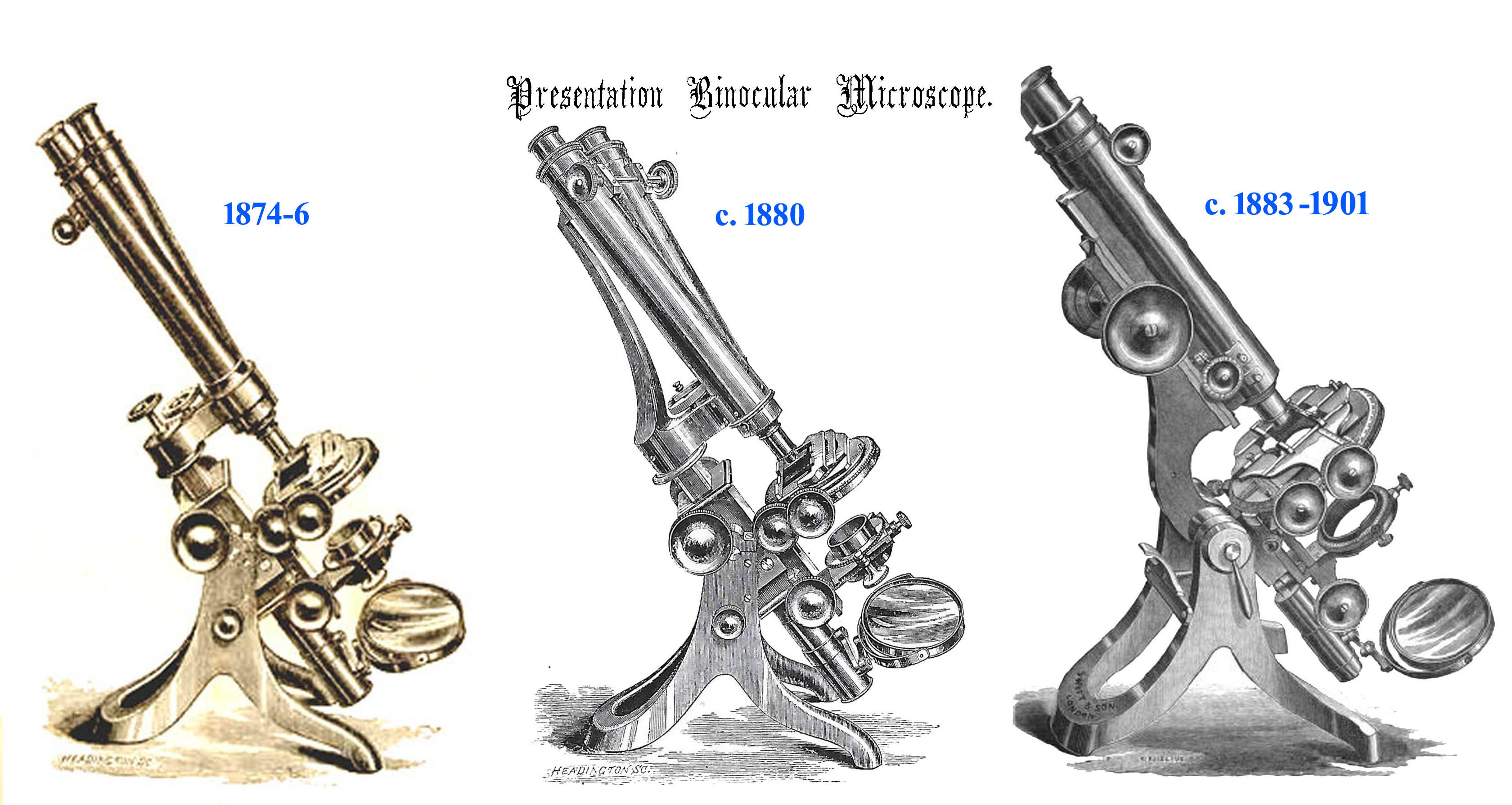 The above represent the only images of Swift presentation microscopes I have been able to find, though as noted above, two other variants were described (but not illustrated), in catalogs.
The above represent the only images of Swift presentation microscopes I have been able to find, though as noted above, two other variants were described (but not illustrated), in catalogs.
CAPTAIN PERRY AND THE PERRY ARM MODIFICATION:
Captain John Anger Perry( -1879) was the Captain of the S.S. Humboldt, built in 1871. This steamship apparently made several transatlantic voyages. His travels apparently gave him opportunities to collect polycystines and diatoms in Haiti. The earliest reference to the Captain Perry Arm I could find is in the Monthly Microscopical Journal (Trans RMS) for 1874, when the demonstration of the arm is mentioned as reported in the Transactions of the Liverpool Literary and Philosophical Society reporting on the Scientific Meeting for April 15 1874. It mentions James Swift himself demonstrating the microscope as well as his Universal condenser (which is also part of this outfit), on that date in Liverpool. This makes sense, since Captain Perry was an associate member of the Liverpool Society. He was elected to that post in 1868. His name is mentioned in the proceedings of that society in 1871 and again(posthumously), in 1884. In 1871 it mentions a clockwork-driven turntable invented by Perry. Perry also advertised in Hardwick's Science gossip in 1873 that he wanted "well-mounted anatomical injections, transparent and opaque" and wanted the respondent to name what he wanted in return. It was reported that Perry died at sea in 1879 and in that report it is mentioned he was a 'skilled and enthusiastic' microscopist. This microscope not only has a Perry Arm, but has the Swift insignia (registered 1877), and the 'Swift New Spiral' rack and pinion focusing which was first introduced about 1877. The signature of 'James Swift' without the son's reference, along with features introduced in 1877, strongly suggests a date for this microscope to before 1878, as by then it would have been signed 'James Swift and Son'. From the available evidence it would seem that the Captain Perry Arm was available only from 1874 to about 1881-2. I note a catalog page from the Tottenham address showing the Presentation Model with the Captain Perry Arm modificiation; since Swift and Son relocated there in 1881, this is evidence that the microscope was still offered at least through that year. We note however that the catalog entry from Tottenham reported the form of the microscope had changed and a new illustration would be provided in the next edition of the catalog. This suggests the Captain Perry Bar Limb Presentation form was going to be replaced in the early 1880's; indeed this was the case, as by 1883 the Presentation Model was in the form of a Lister Limb 'Challenge' Model. The relatively few years that the Captain Perry form was offered likely accounts for the rarity of this form. I am not aware of a Perry-arm microscope in any major museum collection.
FORMER OWNER OF THIS MICROSCOPE:
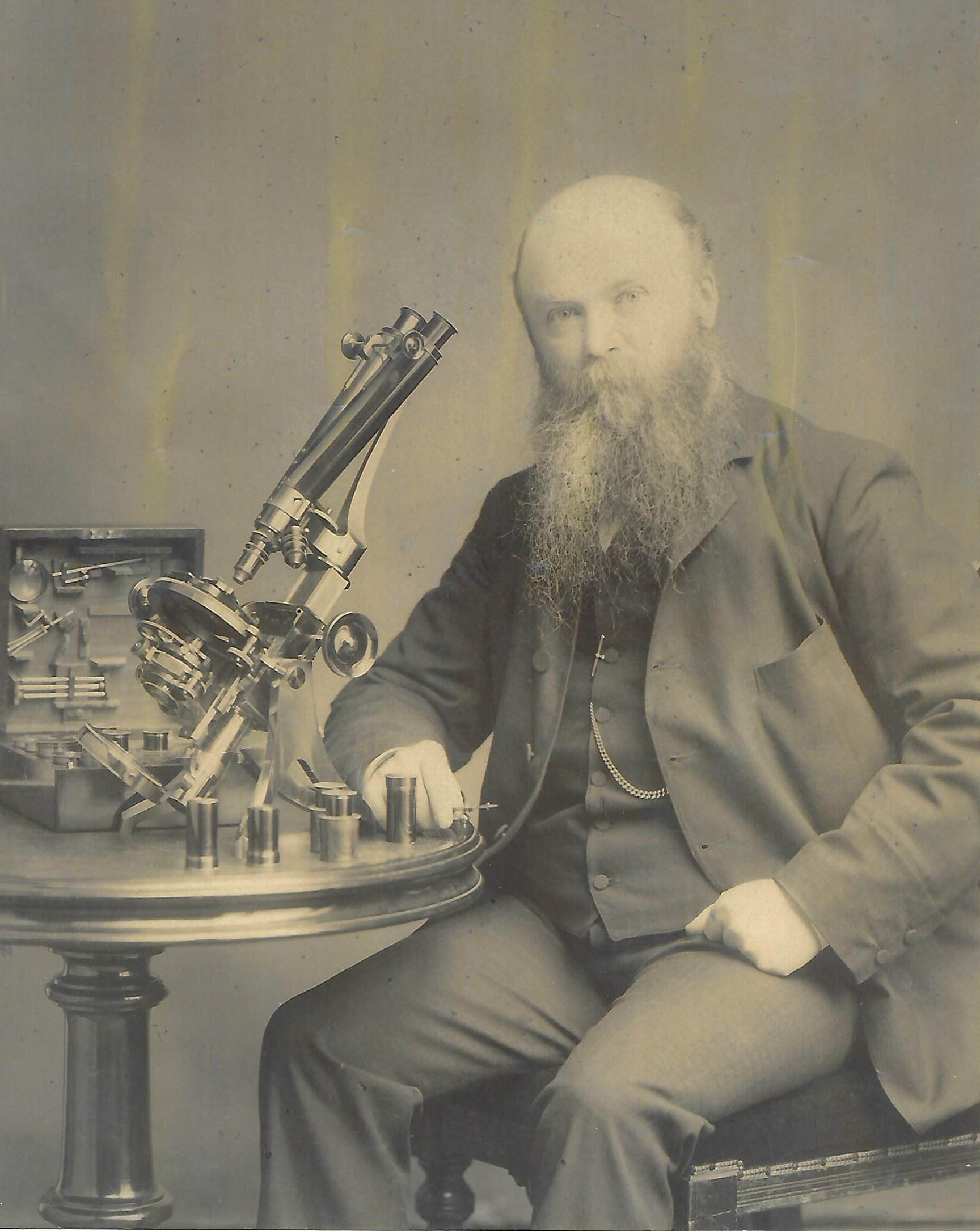
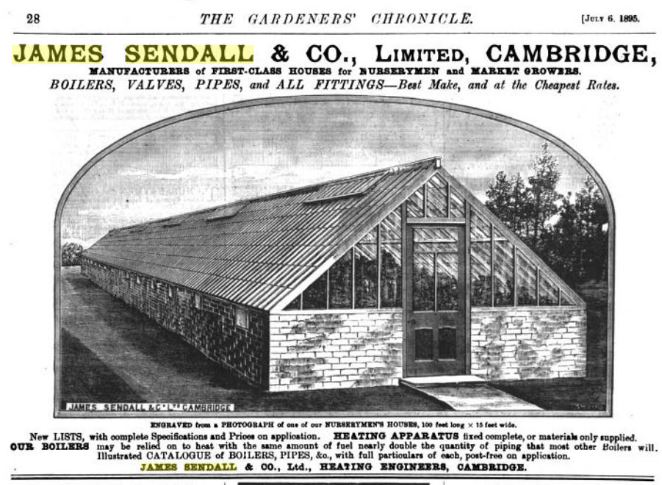 This microscope came with an old black and white photograph of the original owner, James Sendall, R.R.B.S., who is shown in the image to the left. He was the owner of James Sendall & Co, Ltd of Cambridge. The company sold greenhouses and related equipment. Sendall was born in the mid-19th century. He was quoted in a testimonial reference for Florvita, a plant food, in the 1880 edition of the publication titled The Nineteenth Century. He apparently made a good living and resided at 'Oak Lodge' in the Thorpe area of Norwhich in 1880, at about the time this microscope was produced.
This microscope came with an old black and white photograph of the original owner, James Sendall, R.R.B.S., who is shown in the image to the left. He was the owner of James Sendall & Co, Ltd of Cambridge. The company sold greenhouses and related equipment. Sendall was born in the mid-19th century. He was quoted in a testimonial reference for Florvita, a plant food, in the 1880 edition of the publication titled The Nineteenth Century. He apparently made a good living and resided at 'Oak Lodge' in the Thorpe area of Norwhich in 1880, at about the time this microscope was produced.
CONDITION:
The condition of this instrument is really quite excellent with a few areas that need to be pointed out. The microscope stand itself has excellent lacquer with there being some areas of loss of lacquer on the lower part of the foot; lacquer losses are otherwise minimal. Likewise there are some lacquer losses on the plates of the mechanical stage. All the silvered scales are very nice with only a small area of corrosion of the silver scale of the substage. The accessories are mostly in very fine condition though the steel parts have some light rust. The camera lucida has some verdigris as do some small areas of the parabolic side reflector, and tiny areas of some other accessories. In most cases this is limited to the oxidized brass. The silvering of the parabolic reflector and the lieberkuhn are excellent as are both sides of the mirror. The objectives are all clear and functional(except for the 1/4 inch), and cosmetically nice also; as is typical, the correction collars though working, are stiff, especially the 1/4 inch which cannot be turned through its entire range. The 1/4 inch objective also is optically defective. The microspectroscope has superb lacquer and a spectrum can be seen when it is held up to the light. All of its adjustments seem to work normally, though I have not tested it in the microscope. Both the Wenham prism and Analyzer prism are present in their drawers. The livebox is lacking its thin top glass plate but the bottom glass tablet is intact. It also has a spot of lacquer loss and so does the Wenham-type compressor. The parabolic reflector also has some lacquer loss and one of the univeral joints in that accessory has lacquer damage and the ball is loose in the socket. The original case is in very good condition with a partial crack to the rear panel and some screw holes in that panel missing screws. The handle is in good condition. The finish is uneven on the top with a darker finish near the right edge, perhaps due to partial refinishing in the past. The lock and key work well.
**According to a review of a database of sales kindly performed by Dr Joseph Zeligs, this is apparently one of only three Perry-arm microscopes that has been offered for auction in recent decades. One was sold on June 18, 1992 by Christies South Kensington. Another was sold by Breker in Germany on May 27, 2000. Apparently no others have appeared on the auction market for about the last 20 years or so. All three are signed J. Swift with the 43 University St London address. The other two examples are apparently smaller; neither of the other two examples were the Presentation model nor were they as fully equipped as the present example. The author is very grateful to Dr Zeligs for providing us this information.

 DESCRIPTION: This is an all lacquered-brass compound binocular bar-limb microscope with a 'Captain Perry' arm modification. It is signed on the rear bottom portion of the foot: 'James Swift, 43 University St, London W.C., PATENT'. The bird trademark of the Swift is engraved on the rear crossbar. The microscope limb is mounted on the trunnions of a Swift-type English tripod foot. There is a knurled knob on the right side of the microscope attached to a cam which moves a bar which acts as a clutch to adjust the tension of the inclination joint. The arm has the Captain Perry modification which forms part of the casting of the arm; i.e. the arm with the Perry Modification is a single piece of brass. The arm is fastened to the top of the bar and held in place with a set screw. The top of the Perry modification is fastened by two screws to the right binocular tube.
DESCRIPTION: This is an all lacquered-brass compound binocular bar-limb microscope with a 'Captain Perry' arm modification. It is signed on the rear bottom portion of the foot: 'James Swift, 43 University St, London W.C., PATENT'. The bird trademark of the Swift is engraved on the rear crossbar. The microscope limb is mounted on the trunnions of a Swift-type English tripod foot. There is a knurled knob on the right side of the microscope attached to a cam which moves a bar which acts as a clutch to adjust the tension of the inclination joint. The arm has the Captain Perry modification which forms part of the casting of the arm; i.e. the arm with the Perry Modification is a single piece of brass. The arm is fastened to the top of the bar and held in place with a set screw. The top of the Perry modification is fastened by two screws to the right binocular tube. The limb has a small brass plate(yellow arrows, left), screwed to the front, providing a hole on each side of the limb for attachment of accessories; this is identical to the plate used on earlier Ross bar limbs. The lever fine focus is controlled by a micrometer screw in the middle of the arm. The binocular tube incorporates a Wenham prism in a small drawer which can be pulled out the optical axis to allow the microscope to be used as a monocular. Above the Wenham prism drawer is another small drawer containing an analyzer; this is a Swift innovation allowing the use of the analyzer and polarizer with the binocular configuration with less distortion than a nosepiece analyzer inserted below the Wenham prism, and with less vignetting(reducing the effective field of view) than with an eyepiece analyzer. Interocular distance of the binocular tubes is adjusted by rack and pinion, the left side spiral or diagonal, the right side straight. Coarse focus is by diagonal rack and pinion to the wide bar. All scales on this instrument are silvered including the rotation for the substage and the fine focus knob.
The limb has a small brass plate(yellow arrows, left), screwed to the front, providing a hole on each side of the limb for attachment of accessories; this is identical to the plate used on earlier Ross bar limbs. The lever fine focus is controlled by a micrometer screw in the middle of the arm. The binocular tube incorporates a Wenham prism in a small drawer which can be pulled out the optical axis to allow the microscope to be used as a monocular. Above the Wenham prism drawer is another small drawer containing an analyzer; this is a Swift innovation allowing the use of the analyzer and polarizer with the binocular configuration with less distortion than a nosepiece analyzer inserted below the Wenham prism, and with less vignetting(reducing the effective field of view) than with an eyepiece analyzer. Interocular distance of the binocular tubes is adjusted by rack and pinion, the left side spiral or diagonal, the right side straight. Coarse focus is by diagonal rack and pinion to the wide bar. All scales on this instrument are silvered including the rotation for the substage and the fine focus knob.
 The mechanical stage has separate controls for X and Y motion and rotates via a pinion controlled by a knurled knob below the left side of the stage. This gear can be disengaged for manual rotation by moving the gear housing aside. The stage calibrations include silvered scales for X and Y movements as well as a silvered rotational scale. The rotation scale is calibrated from 0-360 degrees in half degree increments, labeled every ten degrees. The finely divided stage X and Y calibrations are labeled from 0 to 100 in single increments and labeled every ten. In use, the slide sits on a top plate which can be pushed forward or backward on rails on top of the mechanical stage, independently of the mechanical movements; this allows one to quickly move to an area of interest, and then use the controls of the stage for finer movements. One slide rest on this plate is fixed, but the other can be moved forward or backward on the moveable plate on which the slide sits. The moveable slide rest has two stage clips and a hole on each side to accept the stage-mounting accessories such as the stage forceps, as an alternative to the holes on the side of the limb. The entire stage is provided with adjustments for centering via knurled knobs on each side.
The mechanical stage has separate controls for X and Y motion and rotates via a pinion controlled by a knurled knob below the left side of the stage. This gear can be disengaged for manual rotation by moving the gear housing aside. The stage calibrations include silvered scales for X and Y movements as well as a silvered rotational scale. The rotation scale is calibrated from 0-360 degrees in half degree increments, labeled every ten degrees. The finely divided stage X and Y calibrations are labeled from 0 to 100 in single increments and labeled every ten. In use, the slide sits on a top plate which can be pushed forward or backward on rails on top of the mechanical stage, independently of the mechanical movements; this allows one to quickly move to an area of interest, and then use the controls of the stage for finer movements. One slide rest on this plate is fixed, but the other can be moved forward or backward on the moveable plate on which the slide sits. The moveable slide rest has two stage clips and a hole on each side to accept the stage-mounting accessories such as the stage forceps, as an alternative to the holes on the side of the limb. The entire stage is provided with adjustments for centering via knurled knobs on each side.  original case, with furniture to store the two accessory boxes, the bullseye stand condenser, and the microspectroscope. It has a working lock and key. There is also a separate key for the larger of the two accessory boxes.
original case, with furniture to store the two accessory boxes, the bullseye stand condenser, and the microspectroscope. It has a working lock and key. There is also a separate key for the larger of the two accessory boxes. 
 There is a nice complement of accessories. Most are housed in two boxes fitting into the main case. They include a good selection of eyepieces, objectives, above stage fittings, and condenser fittings. There is also a microspectroscope and Swift's largest telescoping stand-alone Bullseye Condenser. The microspectroscope and bench condenser store separately in the main case. Among the substage accessories is a Hall type Universal condenser as modified and improved by Swift.
There is a nice complement of accessories. Most are housed in two boxes fitting into the main case. They include a good selection of eyepieces, objectives, above stage fittings, and condenser fittings. There is also a microspectroscope and Swift's largest telescoping stand-alone Bullseye Condenser. The microspectroscope and bench condenser store separately in the main case. Among the substage accessories is a Hall type Universal condenser as modified and improved by Swift.
 The substage accepts the Universal condenser, the paraboloid spot condenser, or the darkwell holder. The substage fitting provides geared rotation with a finely silvered scale indicating the rotation, calibrated in degrees, labeled every ten degrees. It also has controls for centration. Like the optical tube focusing, focusing of the substage is by diagonal rack and spiral pinion-a Swift innovation. Note the slot in the front of the substage to register the Universal condenser.
The substage accepts the Universal condenser, the paraboloid spot condenser, or the darkwell holder. The substage fitting provides geared rotation with a finely silvered scale indicating the rotation, calibrated in degrees, labeled every ten degrees. It also has controls for centration. Like the optical tube focusing, focusing of the substage is by diagonal rack and spiral pinion-a Swift innovation. Note the slot in the front of the substage to register the Universal condenser. 
 The universal condenser provided with this microscope(shown to the left mounted in the substage fitting), is the achromatic 'Universal' type that Swift improved from the Hall condenser. It is a slightly earlier version than the final version which is shown in the engraving to the right. For more images and details of this interesting accessory, please see the Swift Universal Condenser Page. For Carpenters description of the final form of Swift Universal Condenser, see the excerpt from the 1875 edition of Carpenter, which also describes separate selenite stages.
The universal condenser provided with this microscope(shown to the left mounted in the substage fitting), is the achromatic 'Universal' type that Swift improved from the Hall condenser. It is a slightly earlier version than the final version which is shown in the engraving to the right. For more images and details of this interesting accessory, please see the Swift Universal Condenser Page. For Carpenters description of the final form of Swift Universal Condenser, see the excerpt from the 1875 edition of Carpenter, which also describes separate selenite stages.

 The Spot Paraboloid condenser is designed for dark ground work at low powers. It has a fixed spot painted on its inside.
The Spot Paraboloid condenser is designed for dark ground work at low powers. It has a fixed spot painted on its inside. 
 The darkwell holder accepts any of the three different diameter darkwells. These darkwells have unusually long stems. The darkwells are used with a Lieberkuhn reflector. Light reflected by the mirror up through the darkwell holder is re-directed back downward into the darkwell.
The darkwell holder accepts any of the three different diameter darkwells. These darkwells have unusually long stems. The darkwells are used with a Lieberkuhn reflector. Light reflected by the mirror up through the darkwell holder is re-directed back downward into the darkwell.  Eyepieces:
Eyepieces:
 This camera lucida, shown alone to the left and on the microscope to the right, is the 'Wollaston Camera Lucida without Frames' and the second most expensive camera lucida that Swift sold in his 1870's catalogs.
This camera lucida, shown alone to the left and on the microscope to the right, is the 'Wollaston Camera Lucida without Frames' and the second most expensive camera lucida that Swift sold in his 1870's catalogs.
 The five objectives include a 3 inch, a ⅔ inch, a 4/10 inch, a short-barelled ¼ inch with correction collar, and a ⅛ inch with correction collar, all by Swift. There is one Lieberkuhn reflector which fits all the low power objectives. All the objectives are in original cans.
The five objectives include a 3 inch, a ⅔ inch, a 4/10 inch, a short-barelled ¼ inch with correction collar, and a ⅛ inch with correction collar, all by Swift. There is one Lieberkuhn reflector which fits all the low power objectives. All the objectives are in original cans. 
 The Lieberkuhn reflector fits any of the three lowest power objectives. It could be used to illuminate any of the darkwells or to view any small opaque object. For larger opaque objects, the Lieberkuhn cannot be used because the object would block the substage light rays, preventing them from reaching the Lieberkuhn. They would need to be illuminated by the side reflector, or one of the bullseye condensers.
The Lieberkuhn reflector fits any of the three lowest power objectives. It could be used to illuminate any of the darkwells or to view any small opaque object. For larger opaque objects, the Lieberkuhn cannot be used because the object would block the substage light rays, preventing them from reaching the Lieberkuhn. They would need to be illuminated by the side reflector, or one of the bullseye condensers.
 The 'Stage Condenser', shown alone to the left, and also at the blue arrow mounted for use on the stage to the right, is a bullseye condenser that attaches to the holes on either side of the moveable stage slide rest, or to either of the holes, one on each side of the limb. It is usually used in concert with another accessory such as a stage forceps as in the image to the right. It is used to concentrate light on opaque objects.
The 'Stage Condenser', shown alone to the left, and also at the blue arrow mounted for use on the stage to the right, is a bullseye condenser that attaches to the holes on either side of the moveable stage slide rest, or to either of the holes, one on each side of the limb. It is usually used in concert with another accessory such as a stage forceps as in the image to the right. It is used to concentrate light on opaque objects.

 The stage forceps, shown alone to the left and on the microscope at the red arrows to the right, is a very common accessory often supplied with 19th century microscopes. This model was referred to by Swift as the 'Best Stage Forceps' and has a cork-filling casing at the opposite end from the forceps. Holes in the casing allow one to pin objects to this side. The stage forces serves to hold an opaque object like a leaf or insect. It can attach to either of the two holes on the moveable slide rest, or either of the holes, one on either side of the limb. It has two little buttons to open the spring leaf which when released, holds the object. This device works best with soft and and thin objects. Hard and/or larger objects are better held by a three pronged or 'mineral' forceps or, for small hard objects, a small 'stage vice'.
The stage forceps, shown alone to the left and on the microscope at the red arrows to the right, is a very common accessory often supplied with 19th century microscopes. This model was referred to by Swift as the 'Best Stage Forceps' and has a cork-filling casing at the opposite end from the forceps. Holes in the casing allow one to pin objects to this side. The stage forces serves to hold an opaque object like a leaf or insect. It can attach to either of the two holes on the moveable slide rest, or either of the holes, one on either side of the limb. It has two little buttons to open the spring leaf which when released, holds the object. This device works best with soft and and thin objects. Hard and/or larger objects are better held by a three pronged or 'mineral' forceps or, for small hard objects, a small 'stage vice'.

 The Frogplate is shown alone to the left and attached to the moveable stage slide rest of the microscope on the right. It is a device for restraining a frog or fish to study the circulation of the blood. This is done by visualizing a relatively transparent part of the animal, namely the web foot of the frog, or the tail of a fish.
The Frogplate is shown alone to the left and attached to the moveable stage slide rest of the microscope on the right. It is a device for restraining a frog or fish to study the circulation of the blood. This is done by visualizing a relatively transparent part of the animal, namely the web foot of the frog, or the tail of a fish.

 The three pronged forceps or 'Mineral Forceps' enables the user to secure an irregular specimen in the prongs of this device. It could be a rock or mineral specimen being trapped in the center, or something soft and irregular in shape, where the sharp tips of the prongs would hold it. Like the regular stage forceps, lighting from above is neccesary and could be well provided by the stage condenser or a side reflector. The device is adjustable by moving the triangular piece farthest from the sharp prong tips; forward spreads the prongs apart, and backwards brings them closer together. It can attach either to the hole on either side of the moveable stage slide rest, or to one of the side holes of the limb.
The three pronged forceps or 'Mineral Forceps' enables the user to secure an irregular specimen in the prongs of this device. It could be a rock or mineral specimen being trapped in the center, or something soft and irregular in shape, where the sharp tips of the prongs would hold it. Like the regular stage forceps, lighting from above is neccesary and could be well provided by the stage condenser or a side reflector. The device is adjustable by moving the triangular piece farthest from the sharp prong tips; forward spreads the prongs apart, and backwards brings them closer together. It can attach either to the hole on either side of the moveable stage slide rest, or to one of the side holes of the limb.

 The parabolic side reflector is one method of illuminating opaque objects under relatively high power objectives, where the focal length is too short to allow sufficient lighting to be directed from the side e.g. by a bullseye condenser. This device would also fail with very high magnification objectives which require a vertical illuminator for successful illumination when observing opaque objects. The illuminator is silvered and has a blackened cap to protect the silver surface when not in use. It can attach to either of the holes on the moveable slide rest, or to one of the holes on either side of the limb.
The parabolic side reflector is one method of illuminating opaque objects under relatively high power objectives, where the focal length is too short to allow sufficient lighting to be directed from the side e.g. by a bullseye condenser. This device would also fail with very high magnification objectives which require a vertical illuminator for successful illumination when observing opaque objects. The illuminator is silvered and has a blackened cap to protect the silver surface when not in use. It can attach to either of the holes on the moveable slide rest, or to one of the holes on either side of the limb.
 This compressor is to the design of Francis Wenham. Two different Wenham compressors were sold by Swift. This one is apparently the smaller(the larger is not illustrated in the Swift catalogs). It features a bottom glass tablet close to the stage allowing the use of the achromatic condenser and dark ground illumination. The tablet has beveled edge on the top. The small knurled knob raises the top when turned clockwise, or releases its spring action when turned counterclockwise. The top plate has a thin slit in the brass to accept a simple square cover slip.
This compressor is to the design of Francis Wenham. Two different Wenham compressors were sold by Swift. This one is apparently the smaller(the larger is not illustrated in the Swift catalogs). It features a bottom glass tablet close to the stage allowing the use of the achromatic condenser and dark ground illumination. The tablet has beveled edge on the top. The small knurled knob raises the top when turned clockwise, or releases its spring action when turned counterclockwise. The top plate has a thin slit in the brass to accept a simple square cover slip.
 This livebox is specifically designed to allow the use of the achromatic condenser and dark ground illumination. Swift's catalogs attributed it to Blankley. It was described in the English Mechanic and World of Science No. 305, of Jan 27 1871, page 437. It is stated in the article that it was made and sold by 'Mr James Swift of 48 University Street, Tottenham-court-road and costs but a trifle more than an ordinary live-box'. This livebox very much anticipated the much later 'Rouselet livebox' of similar construction.
This livebox is specifically designed to allow the use of the achromatic condenser and dark ground illumination. Swift's catalogs attributed it to Blankley. It was described in the English Mechanic and World of Science No. 305, of Jan 27 1871, page 437. It is stated in the article that it was made and sold by 'Mr James Swift of 48 University Street, Tottenham-court-road and costs but a trifle more than an ordinary live-box'. This livebox very much anticipated the much later 'Rouselet livebox' of similar construction.

 Dissecting instruments include three ivory-handled instruments. The ivory handled instruments are signed on the metal portion nearest the handles 'J SWIFT, MAKER'. They correspond to numbers 5, 6 and 9 in the 1876 and earlier catalogs.
Dissecting instruments include three ivory-handled instruments. The ivory handled instruments are signed on the metal portion nearest the handles 'J SWIFT, MAKER'. They correspond to numbers 5, 6 and 9 in the 1876 and earlier catalogs.  Among the tools included with the Swift Perry-Arm Presentation microscope is a hand held lacquered brass forceps. In some catalogs, hand forceps were referred to as 'pliers'. This is an example of the No 7 'Second Size Bottle Pliers'.
Among the tools included with the Swift Perry-Arm Presentation microscope is a hand held lacquered brass forceps. In some catalogs, hand forceps were referred to as 'pliers'. This is an example of the No 7 'Second Size Bottle Pliers'.  Microspectroscope:
Microspectroscope: Swift offered a number of different bench condensers, but this is the largest model offered with the highest maximum height; he called it his 'Speciality Condenser'. It features a 3 inch diameter lens. It has the maximum height and most versatile adjustments of any of the bench condensers of that time period by any maker. Not only does it telescope in two different directions(vertically and at any angle for the second part), but knurled clamping knobs can hold the the two positions set. Bench condensers are used to concentrate light, and are typically used for illuminating opaque objects from above or the side. Because of the stand-alone design, adjustments will not disturb the arrangement of the microscope as much as a a stage-mounted condenser could. The round base is unscrewed and the two parts then store in the main case.
Swift offered a number of different bench condensers, but this is the largest model offered with the highest maximum height; he called it his 'Speciality Condenser'. It features a 3 inch diameter lens. It has the maximum height and most versatile adjustments of any of the bench condensers of that time period by any maker. Not only does it telescope in two different directions(vertically and at any angle for the second part), but knurled clamping knobs can hold the the two positions set. Bench condensers are used to concentrate light, and are typically used for illuminating opaque objects from above or the side. Because of the stand-alone design, adjustments will not disturb the arrangement of the microscope as much as a a stage-mounted condenser could. The round base is unscrewed and the two parts then store in the main case.
 In the catalog of about 1865, from 15 Kingsland Road, all the microscopes listed were bar-limbs, likely reflecting Swift's previous association with Ross. The 'Best Compound No. 1A(left)very closely resembled the first class bar limb of Ross, complete with two uprights. The 'Presentation' binocular microscope in that catalog was described as supplied with 'milled heads of rich gun metal' and the screws were all blued steel; these blued steel screws became a feature found on many of the later Swift stands, but during this earlier period, and for many years to come, the blued screws were not a common feature. That Presentation microscope of 1865 included the centerable and rack-rotatable substage. But there was no illustration of this version of the Presentation microscope in that 1865 catalog.
In the catalog of about 1865, from 15 Kingsland Road, all the microscopes listed were bar-limbs, likely reflecting Swift's previous association with Ross. The 'Best Compound No. 1A(left)very closely resembled the first class bar limb of Ross, complete with two uprights. The 'Presentation' binocular microscope in that catalog was described as supplied with 'milled heads of rich gun metal' and the screws were all blued steel; these blued steel screws became a feature found on many of the later Swift stands, but during this earlier period, and for many years to come, the blued screws were not a common feature. That Presentation microscope of 1865 included the centerable and rack-rotatable substage. But there was no illustration of this version of the Presentation microscope in that 1865 catalog.  By about 1873, Swift's catalog from 43 University street contained both a 'Best Compound Microscope No. 1'(same as 1A of 1865) of bar-limb construction, and also a 'Best Compound microscope of the Jackson-Lister or 'Crane Arm' form No. 1'(both shown to the left). Both were still supported by uprights as in the original Ross design for his Bar Limbs. During this time though, a much more expensive Presentation Microscope was offered made of 'German Silver and rich Gun metal heads' also with the blued steel screws. This cost a whopping £80 or twice the price of the first class stands. Again, only a description, and no illustration was provided for this more ostentatious Presentation model.
By about 1873, Swift's catalog from 43 University street contained both a 'Best Compound Microscope No. 1'(same as 1A of 1865) of bar-limb construction, and also a 'Best Compound microscope of the Jackson-Lister or 'Crane Arm' form No. 1'(both shown to the left). Both were still supported by uprights as in the original Ross design for his Bar Limbs. During this time though, a much more expensive Presentation Microscope was offered made of 'German Silver and rich Gun metal heads' also with the blued steel screws. This cost a whopping £80 or twice the price of the first class stands. Again, only a description, and no illustration was provided for this more ostentatious Presentation model.
 As stated in the 6th edition catalog of about 1874, the Presentation microscope was once again a lacquered brass model costing £40 but now with the new bent type of Swift tripod stand. The Best compound No. 1 (the same as 1A of 1865 and No. 1 of the catalog of about 1873), both the bar limb and the Jackson-Lister limb, remained atop the two uprights.
As stated in the 6th edition catalog of about 1874, the Presentation microscope was once again a lacquered brass model costing £40 but now with the new bent type of Swift tripod stand. The Best compound No. 1 (the same as 1A of 1865 and No. 1 of the catalog of about 1873), both the bar limb and the Jackson-Lister limb, remained atop the two uprights.  Also new in the c. 1874 catalog, on page 11, was 'Captain Perry's New Form of Arm of Microscope' which featured the sculptural support arising from the arm to support the top of the right binocular tube. This microscope was offered with four options including the monocular, the binocular, with an analyser added above the binocular prism, a goniometer stage, and the rack & pinion substage added to all the above for a total cost of about £43, about £3 above the price of the Presentation model. This could then be a 'Perry-arm Presentation microscope', though not called that in the catalog of 1874.
Also new in the c. 1874 catalog, on page 11, was 'Captain Perry's New Form of Arm of Microscope' which featured the sculptural support arising from the arm to support the top of the right binocular tube. This microscope was offered with four options including the monocular, the binocular, with an analyser added above the binocular prism, a goniometer stage, and the rack & pinion substage added to all the above for a total cost of about £43, about £3 above the price of the Presentation model. This could then be a 'Perry-arm Presentation microscope', though not called that in the catalog of 1874.
 In the 7th Edition of Swift's catalog of 1876, the 'Presentation' microscope was the same as in the 6th edition. However it is in the 7th edition of 1876 that a microscope is labeled as the 'Challenge' and this version was later to become the lowest class of the Challenge series, the 'Challenge A'. Unfortunately, I do not have access to a full copy of the 1876 catalog, only a few pages.
In the 7th Edition of Swift's catalog of 1876, the 'Presentation' microscope was the same as in the 6th edition. However it is in the 7th edition of 1876 that a microscope is labeled as the 'Challenge' and this version was later to become the lowest class of the Challenge series, the 'Challenge A'. Unfortunately, I do not have access to a full copy of the 1876 catalog, only a few pages.  In his 1880 publication Hints to the Uninitiated..., Swift pictures a 'Complete microscope' which is actually the 'Best Challenge' model referred to later, but with a short lever nosepiece fine adjustment instead of the later side fine adjustment.
In his 1880 publication Hints to the Uninitiated..., Swift pictures a 'Complete microscope' which is actually the 'Best Challenge' model referred to later, but with a short lever nosepiece fine adjustment instead of the later side fine adjustment.  In the JRMS of 1881 the 'Challenge C' was pictured to show that the fine adjustment had changed to the side adjusted version. It is clear that the use of the term 'Challenge' to describe this series of microscopes had been adapted before 1881. As noted above, this term was first used in a Swift catalog in 1876.
In the JRMS of 1881 the 'Challenge C' was pictured to show that the fine adjustment had changed to the side adjusted version. It is clear that the use of the term 'Challenge' to describe this series of microscopes had been adapted before 1881. As noted above, this term was first used in a Swift catalog in 1876.
 In a catalog from about 1881-2, from the Tottenham address, the engraving of the 'Swift Binocular Presentation Microscope' is shown to the right. This is the only engraving the author has found clearly showing a Perry-Arm bar-limb Presentation model; it had a caption below it, appologizing for using this engraving, noting that this model was no longer going to be the form of the Presentation Model from that time forward. Indeed this was true by 1883 when the engraving showed the Presentation model as a Lister Limb type, as shown in the next paragraph.
In a catalog from about 1881-2, from the Tottenham address, the engraving of the 'Swift Binocular Presentation Microscope' is shown to the right. This is the only engraving the author has found clearly showing a Perry-Arm bar-limb Presentation model; it had a caption below it, appologizing for using this engraving, noting that this model was no longer going to be the form of the Presentation Model from that time forward. Indeed this was true by 1883 when the engraving showed the Presentation model as a Lister Limb type, as shown in the next paragraph. In his longer book, The Microscope and Accessory Apparatus..., published in 1883, the same engraving, i.e. the 'Best Challenge' is now referred to as the 'First Class Compound Binocular Microscope'. The only microscope in this publication referred to as a Challenge is actually the 'Challenge A', the simplest form of the Challenge.
Also in this book of 1883, is pictured the version of the 'Presentation' Microscope' which would be found unchanged from that time forward, until at least 1901. Of lacquered brass, and slightly larger than the 'Best Challenge' The main difference between the two, other than size, was the 'Presentation' had the 'Climax' side fine adjustment. But this fine adjustment was also supplied with the 'Best Challenge no later than 1892
In his longer book, The Microscope and Accessory Apparatus..., published in 1883, the same engraving, i.e. the 'Best Challenge' is now referred to as the 'First Class Compound Binocular Microscope'. The only microscope in this publication referred to as a Challenge is actually the 'Challenge A', the simplest form of the Challenge.
Also in this book of 1883, is pictured the version of the 'Presentation' Microscope' which would be found unchanged from that time forward, until at least 1901. Of lacquered brass, and slightly larger than the 'Best Challenge' The main difference between the two, other than size, was the 'Presentation' had the 'Climax' side fine adjustment. But this fine adjustment was also supplied with the 'Best Challenge no later than 1892 The above images illustrate the differences in the fully developed Presentation and Challenge microscope series, as illustrated in the 1892 catalog. The Presentation model was slightly larger than the 'Best Challenge' but was otherwise similar. Both had mechanical stages with geared rotation, rack and pinion centerable substages, etc. Besides the slightly larger size, the Presentation microscope had a built in handle to adjust the tension of the inclination joint, whereas all the Challenge microscopes required the use of an adjustment tool, as described above, to do this. The Challenge C, B and A were apparently all about the same size. The C model differed from the Best Challenge in being slightly smaller and having only manual rotation to the stage without gearing. The B model was the same but had no rack and pinion substage; instead it had provision for substage apparatus under the stage. The A model was the same as the B without a substage apparatus, but with a dovetail under the stage to accept such later. All were available in monocular or binocular forms.
The above images illustrate the differences in the fully developed Presentation and Challenge microscope series, as illustrated in the 1892 catalog. The Presentation model was slightly larger than the 'Best Challenge' but was otherwise similar. Both had mechanical stages with geared rotation, rack and pinion centerable substages, etc. Besides the slightly larger size, the Presentation microscope had a built in handle to adjust the tension of the inclination joint, whereas all the Challenge microscopes required the use of an adjustment tool, as described above, to do this. The Challenge C, B and A were apparently all about the same size. The C model differed from the Best Challenge in being slightly smaller and having only manual rotation to the stage without gearing. The B model was the same but had no rack and pinion substage; instead it had provision for substage apparatus under the stage. The A model was the same as the B without a substage apparatus, but with a dovetail under the stage to accept such later. All were available in monocular or binocular forms.
 The above represent the only images of Swift presentation microscopes I have been able to find, though as noted above, two other variants were described (but not illustrated), in catalogs.
The above represent the only images of Swift presentation microscopes I have been able to find, though as noted above, two other variants were described (but not illustrated), in catalogs.

 This microscope came with an old black and white photograph of the original owner, James Sendall, R.R.B.S., who is shown in the image to the left. He was the owner of James Sendall & Co, Ltd of Cambridge. The company sold greenhouses and related equipment. Sendall was born in the mid-19th century. He was quoted in a testimonial reference for Florvita, a plant food, in the 1880 edition of the publication titled The Nineteenth Century. He apparently made a good living and resided at 'Oak Lodge' in the Thorpe area of Norwhich in 1880, at about the time this microscope was produced.
This microscope came with an old black and white photograph of the original owner, James Sendall, R.R.B.S., who is shown in the image to the left. He was the owner of James Sendall & Co, Ltd of Cambridge. The company sold greenhouses and related equipment. Sendall was born in the mid-19th century. He was quoted in a testimonial reference for Florvita, a plant food, in the 1880 edition of the publication titled The Nineteenth Century. He apparently made a good living and resided at 'Oak Lodge' in the Thorpe area of Norwhich in 1880, at about the time this microscope was produced.